Category
History of Photography
24 entries in this category | view all categories
Rule Breaker; Dream Maker
Posted January 2014 in Exhibitions, History of Photography, Significant Photographers
Subversive and unwilling to play by the rules. This is why the body of work produced by British photographer Julia Margaret Cameron (1815–1879) should still matter to us today.
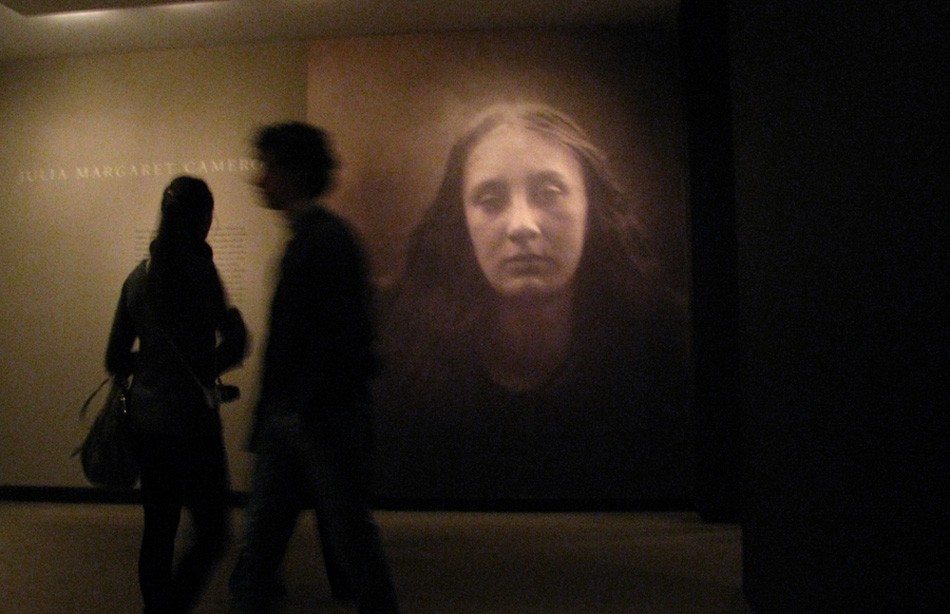 Silhouetted visitors to the Metropolitan Museum of Art's Gallery 852 in December, 2013 are seen in the entryway to the exhibit with a wall-mounted, mural-sized version of the Cameron photograph "Christabel" taken in 1866 in the background. The show was open from August 19, 2013 to January 5, 2014. PhotoSeed Archive photograph by David Spencer
Silhouetted visitors to the Metropolitan Museum of Art's Gallery 852 in December, 2013 are seen in the entryway to the exhibit with a wall-mounted, mural-sized version of the Cameron photograph "Christabel" taken in 1866 in the background. The show was open from August 19, 2013 to January 5, 2014. PhotoSeed Archive photograph by David Spencer
How can one not admire the intent and courage it must have taken her to focus a camera lens in the era of wet plate photography (1860s-1870s) and then, just as often as not, deliberately have the mischievous bent to throw that lens slightly out of focus in order to create photographs often resembling the feelings found in dreams? Photographs that justifiably draw admiration and discussion even today of the lives of Victorian celebrities and house servants who were convinced to sit or be dragged in front of that camera.
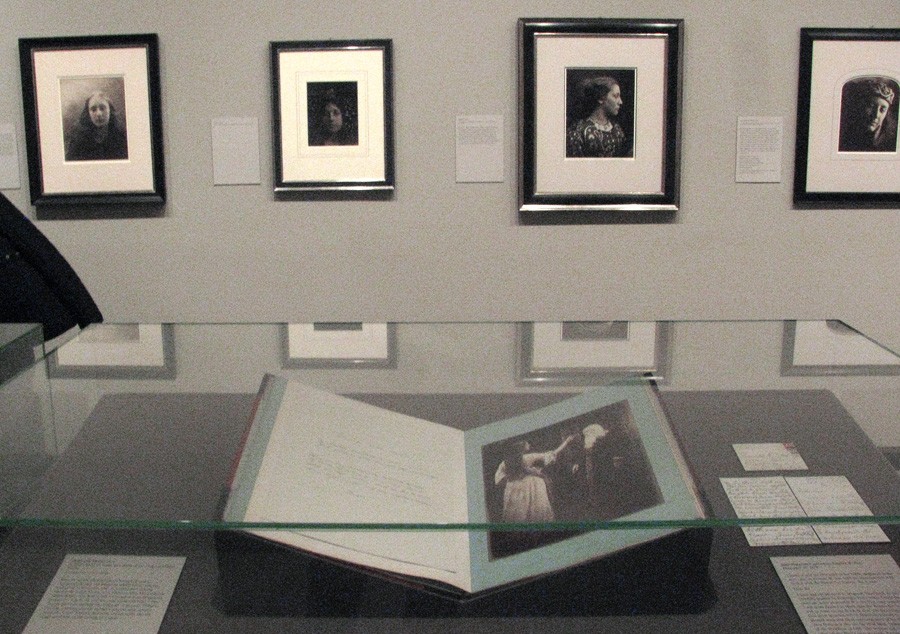 Organized by Malcolm Daniel, Senior Curator in the Department of Photographs at the Met, the tightly edited show featured 35 framed vintage works by Cameron as well as several photographs by her contemporaries. The glass display case in this installation view displayed several folio volumes of the work "Illustrations to Tennyson's Idylls of the King, and Other Poems" published by Henry S. King in London in 1875. The work seen here at front is "Vivien and Merlin" (1874)- one 24 original photographs that appeared in the double volume folio. PhotoSeed Archive photograph by David Spencer
Organized by Malcolm Daniel, Senior Curator in the Department of Photographs at the Met, the tightly edited show featured 35 framed vintage works by Cameron as well as several photographs by her contemporaries. The glass display case in this installation view displayed several folio volumes of the work "Illustrations to Tennyson's Idylls of the King, and Other Poems" published by Henry S. King in London in 1875. The work seen here at front is "Vivien and Merlin" (1874)- one 24 original photographs that appeared in the double volume folio. PhotoSeed Archive photograph by David Spencer
For those inclined to learn the mysterious ingredient-and staying power so to speak-of Cameron’s photography-the answer might be a single word: “beauty”. This might indeed be the key, a Citizen Kane, Rosebud moment if you will, the one final word she reportedly uttered on her deathbed.
Beauty, and a renewed appreciation is what I took away from a visit late last year to a show at the Metropolitan Museum of Art simply titled “Julia Margaret Cameron”.
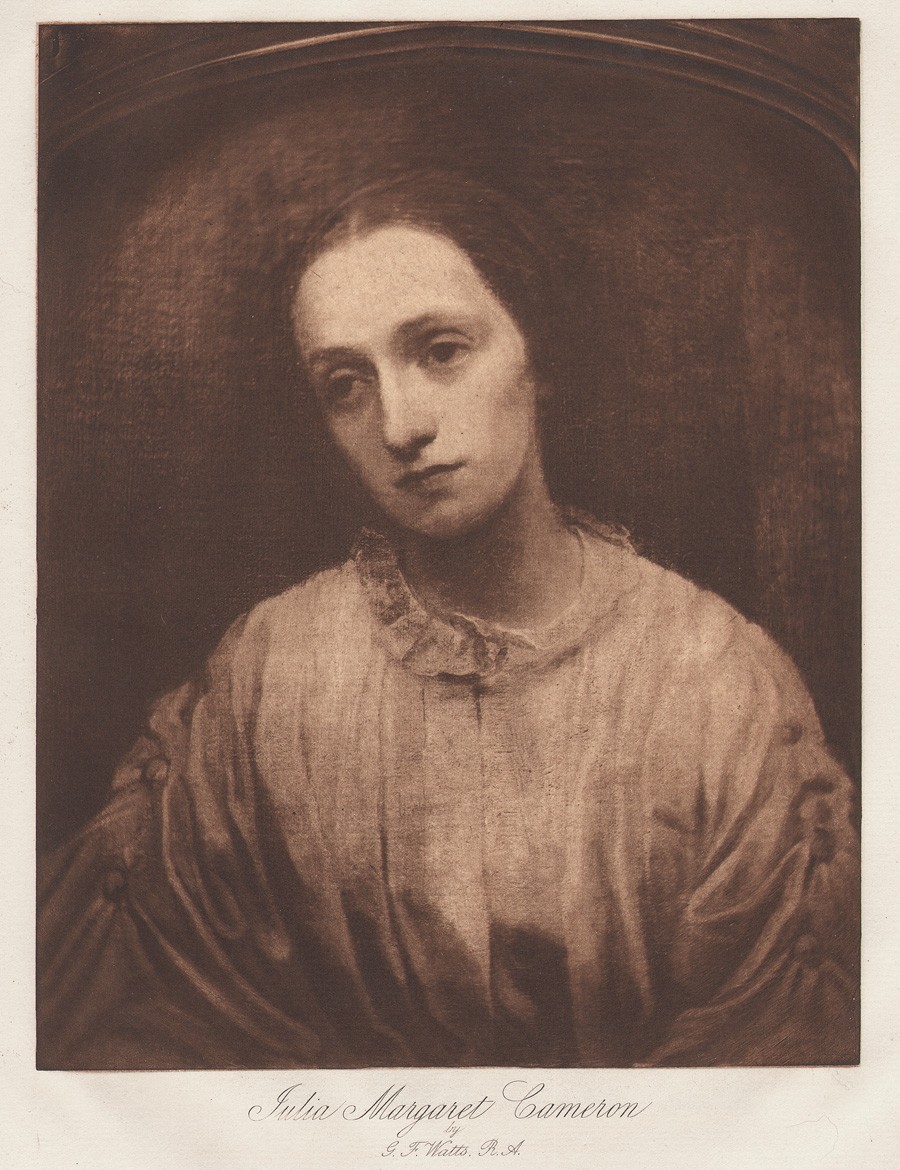 A painting by English artist George Frederick Watts of Julia Margaret Cameron completed in 1852 is reproduced here as a large format plate photogravure included in the 1893 folio volume "Alfred, Lord Tennyson and his Friends" published in London by T. Fisher Unwin in a limited edition. image: 24.5 x 19.3 cm : laid paper cream-colored leaf: 44.3 x 36.0 cm. from: PhotoSeed Archive
A painting by English artist George Frederick Watts of Julia Margaret Cameron completed in 1852 is reproduced here as a large format plate photogravure included in the 1893 folio volume "Alfred, Lord Tennyson and his Friends" published in London by T. Fisher Unwin in a limited edition. image: 24.5 x 19.3 cm : laid paper cream-colored leaf: 44.3 x 36.0 cm. from: PhotoSeed Archive
Surprisingly, it was first devoted solely to her work at the museum, a tightly edited overview comprised of 38 works, including several by her contemporaries: David Wilkie Wynfield, William Frederick Lake Price, and Oscar Gustav Rejlander.
The wall copy set the stage for those not already familiar with Cameron, describing her rightly as:
”One of the greatest portraitists in the history of photography—indeed in any medium“…
A further explanatory statement in her own words followed:
”From the first moment I handled my lens with a tender ardour,” she wrote, “and it has become to me as a living thing, with voice and memory and creative vigour.”
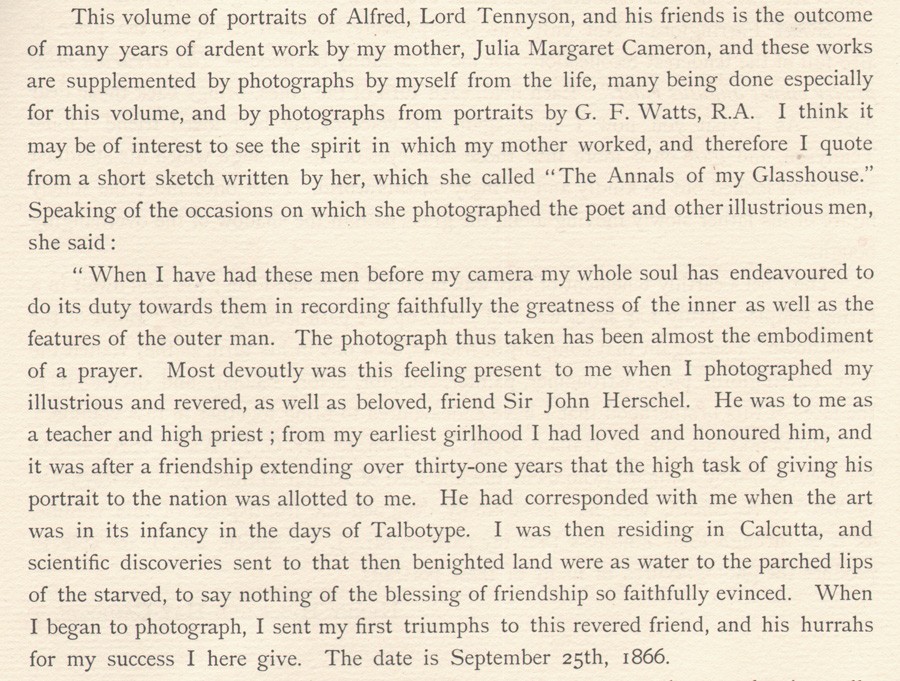 A detail from the first page of the letterpress Introduction to "Alfred, Lord Tennyson and his Friends"(1893) by Cameron's son Henry Herschel Hay Cameron. A quote from her "Annals of my Glasshouse" states she felt the photographs taken of illustrious men were akin to being "almost the embodiment of a prayer". from: PhotoSeed Archive
A detail from the first page of the letterpress Introduction to "Alfred, Lord Tennyson and his Friends"(1893) by Cameron's son Henry Herschel Hay Cameron. A quote from her "Annals of my Glasshouse" states she felt the photographs taken of illustrious men were akin to being "almost the embodiment of a prayer". from: PhotoSeed Archive
Words that no doubt have influenced scores of photographers, painters and others working in various artistic disciplines during the many decades since her passing. An important early tribute came in the lifetime of Cameron’s youngest son Henry Herschel Hay Cameron. (1852-1911) Inspired no doubt by his mother’s art, he was a working photographer who maintained a London studio, and provided the Introduction as well as a series of complimentary portraits paired with those by his mother for the folio volume Alfred, Lord Tennyson and his Friends. This series of 25 large-plate photogravures along with letterpress was published in a limited edition in 1893.
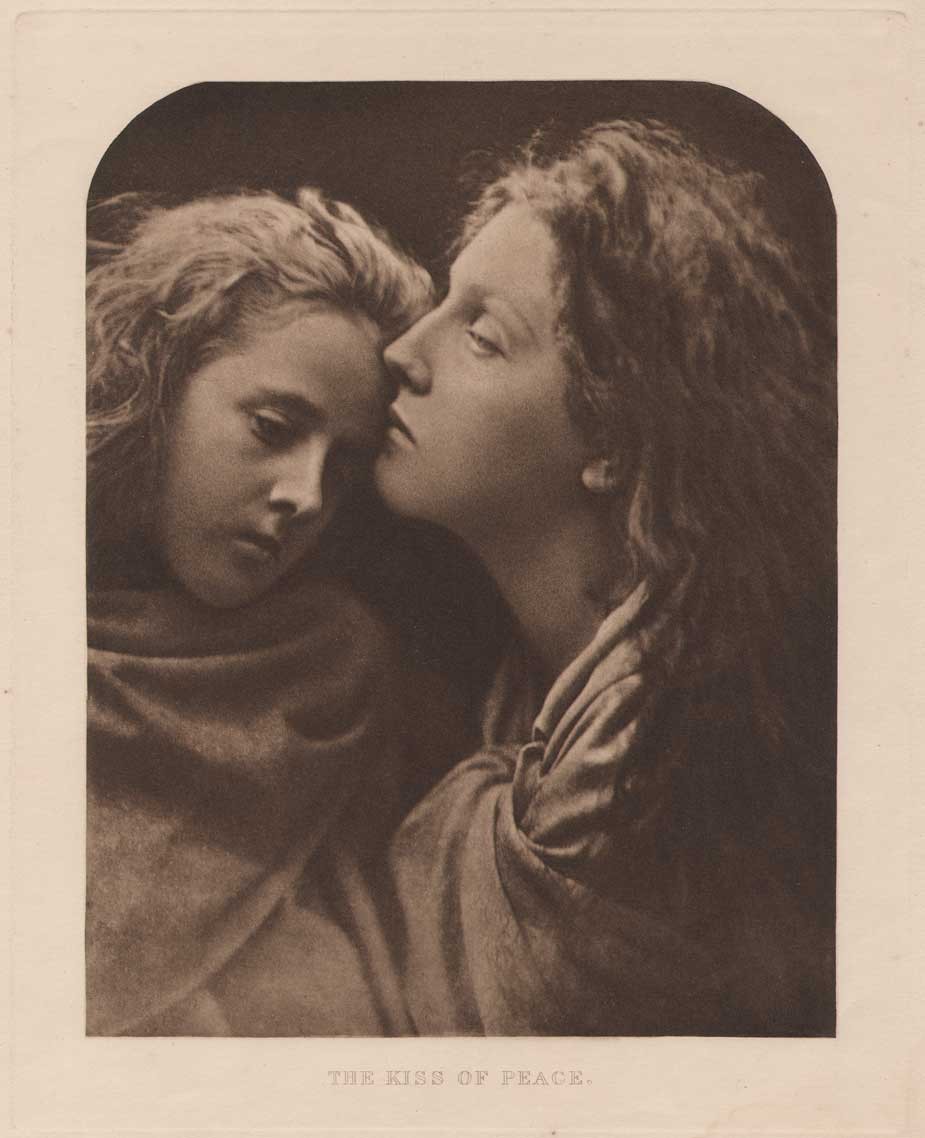 Inspired by the Biblical story of the Visitation, "The Kiss of Peace" is shown here as a large plate photogravure included with the 5th issue of the English publication "Sun Artists" published in 1890. Taken in 1869 by Cameron, it is believed to show Florence Anson at left, the daughter of Lord Litchfield, and Mary Hillier, Cameron's personal maid. See: JMC: The Complete Photographs, cat. #1129. image: 21.8 x 17.1 cm: sheet: 38.0 x 28.4 cm: Vintage gravure from PhotoSeed Archive.
Inspired by the Biblical story of the Visitation, "The Kiss of Peace" is shown here as a large plate photogravure included with the 5th issue of the English publication "Sun Artists" published in 1890. Taken in 1869 by Cameron, it is believed to show Florence Anson at left, the daughter of Lord Litchfield, and Mary Hillier, Cameron's personal maid. See: JMC: The Complete Photographs, cat. #1129. image: 21.8 x 17.1 cm: sheet: 38.0 x 28.4 cm: Vintage gravure from PhotoSeed Archive.
Other notable remembrances of Cameron’s work appeared earlier and much later. In 1890, the English publication Sun Artists featured four of her photographs: Sir John Herschel, Alfred Lord Tennyson and the allegorical works The Day Dream and The Kiss of Peace. All large-plate gravures for the 5th Number.
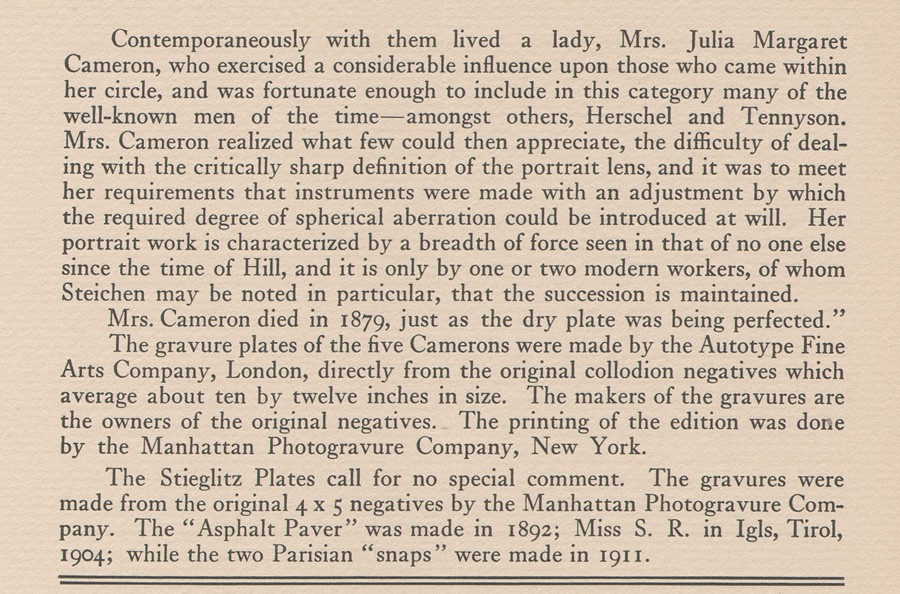 Editor Alfred Stieglitz gave background to Cameron's work he published in Camera Work XLI, (1913) with a nod to her willingness to break rules when it came to portraiture: "Mrs. Cameron realized what few could then appreciate, the difficulty of dealing with the critically sharp definition of the portrait lens, and it was to meet her requirements that instruments were made with an adjustment by which the required degree of spherical aberration could be introduced at will." detail: vintage letterpress page from PhotoSeed Archive.
Editor Alfred Stieglitz gave background to Cameron's work he published in Camera Work XLI, (1913) with a nod to her willingness to break rules when it came to portraiture: "Mrs. Cameron realized what few could then appreciate, the difficulty of dealing with the critically sharp definition of the portrait lens, and it was to meet her requirements that instruments were made with an adjustment by which the required degree of spherical aberration could be introduced at will." detail: vintage letterpress page from PhotoSeed Archive.
For Camera Work 41 published in 1913, editor Alfred Stieglitz presented five plates of Cameron’s work published as tissue gravures: two of Scottish philosopher Thomas Carlyle, portraits of English polymath John Herschel and Hungarian violinist Joseph Joachim and an allegorical study of English Shakespearean actress Ellen Terry taken done in 1864 when she was 16 originally titled “Sadness”.
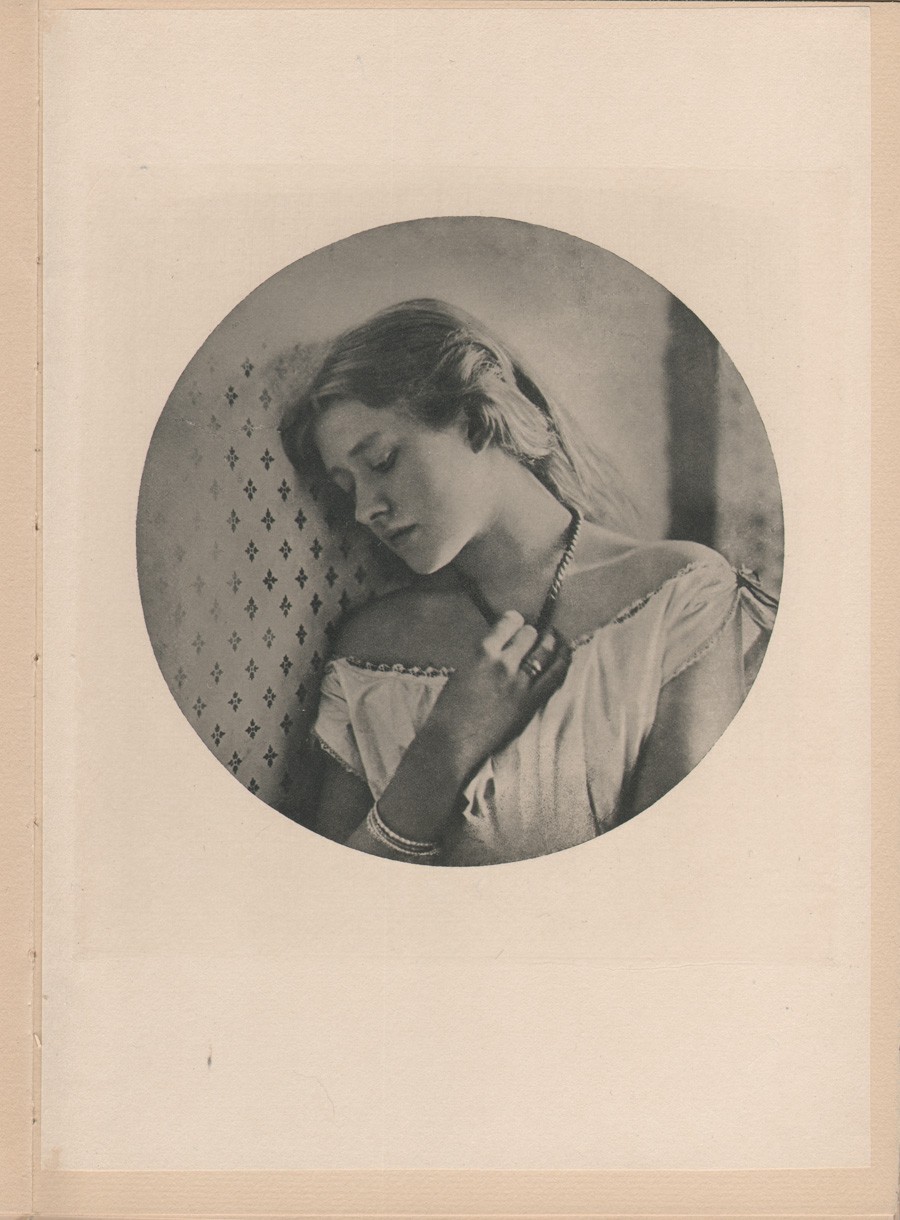 English Shakespearean actress Ellen Terry was included as a hand-pulled, Japanese tissue photogravure in Camera Work XLI,(1913) photographed by Cameron in 1864 when she was 16 years of age. The allegorical photograph originally carried the title of "Sadness". entire vintage tipped plate shown on original CW mount: circular image: 15.7 cm | sheet: 28.0 x 20.1 cm | mount: 29.4 x 21.0 cm. from PhotoSeed Archive
English Shakespearean actress Ellen Terry was included as a hand-pulled, Japanese tissue photogravure in Camera Work XLI,(1913) photographed by Cameron in 1864 when she was 16 years of age. The allegorical photograph originally carried the title of "Sadness". entire vintage tipped plate shown on original CW mount: circular image: 15.7 cm | sheet: 28.0 x 20.1 cm | mount: 29.4 x 21.0 cm. from PhotoSeed Archive
Later in the British Number of the short-lived publication Platinum Print published in Feb. 1915, American photographer Clarence White’s essay titled Old Masters in Photography lauded Cameron as an early influence, singling out her photograph he most likely saw in an 1891 issue of Sun and Shade titled the Dalmatian Maid.
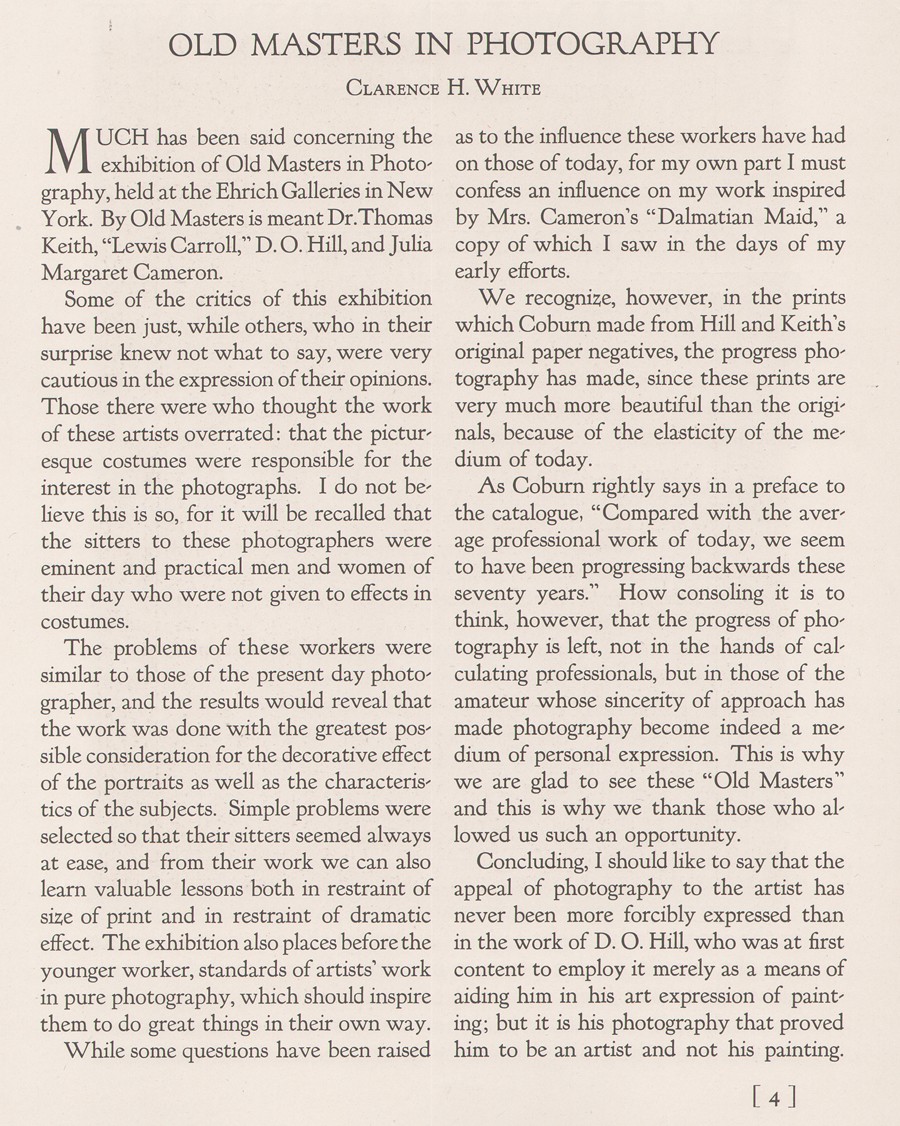 Julia Margaret Cameron was one of "The Old Masters of Photography" exhibit arranged by Alvin Langdon Coburn and presented at the Ehrich Galleries of New York City in December, 1914. Author Clarence White weighs in on the exhibit, discussing the influence of Cameron on his own work. Single letterpress page from "Platinum Print": Feb. 1915: PhotoSeed Archive
Julia Margaret Cameron was one of "The Old Masters of Photography" exhibit arranged by Alvin Langdon Coburn and presented at the Ehrich Galleries of New York City in December, 1914. Author Clarence White weighs in on the exhibit, discussing the influence of Cameron on his own work. Single letterpress page from "Platinum Print": Feb. 1915: PhotoSeed Archive
This portrait of Christina Spartali, a neighbor of Cameron on the Isle of Wight who was most certainly not a maid, as her family had made their fortune from the cotton trade and her father was Consul-General for Greece, was taken in 1868. White observed:
”While some questions have been raised as to the influence these workers have had on those of today, for my own part I must confess an influence on my work inspired by Mrs. Cameron’s “Dalmatian Maid,” a copy of which I saw in the days of my early efforts.” (p.4)
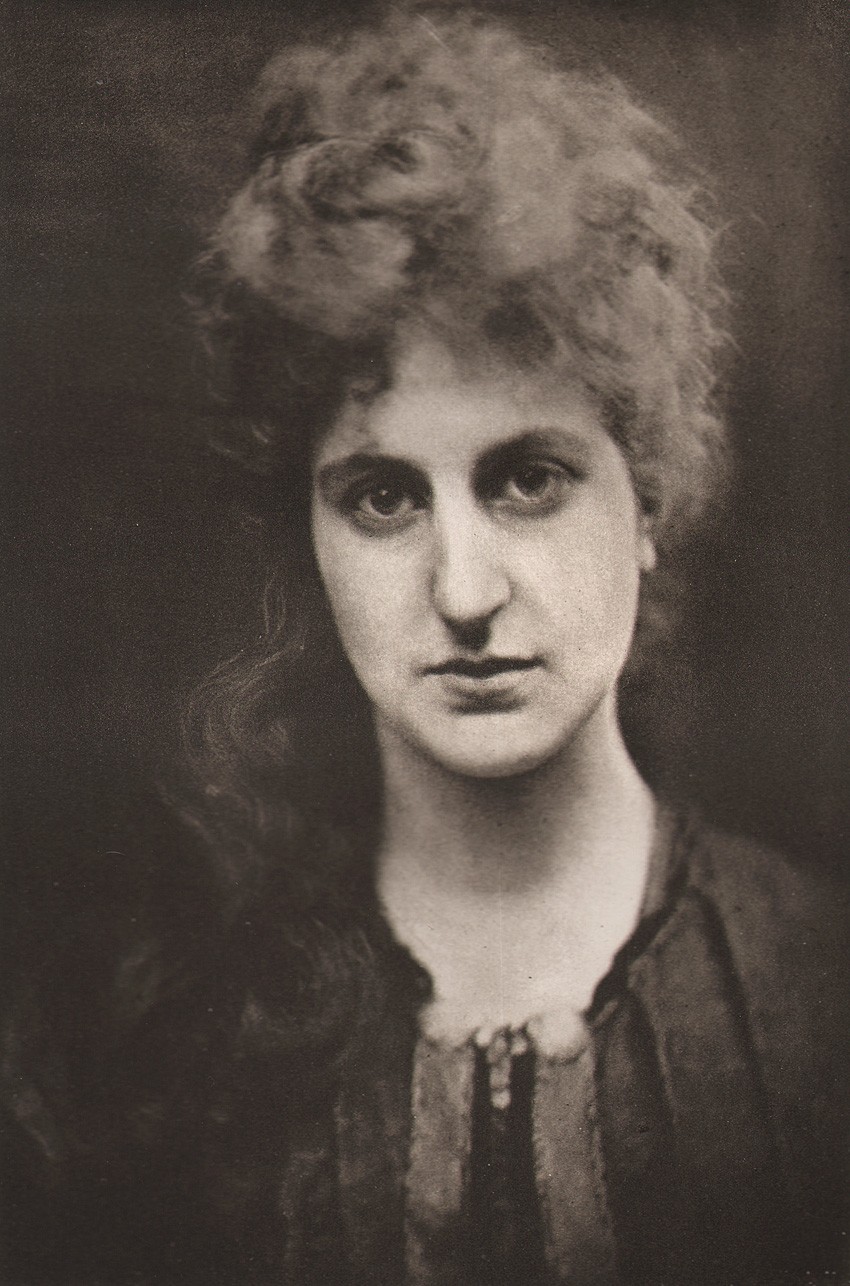 "A Dalmatian Maid", taken in 1868, is a portrait of Christina Spartali, a neighbor to Cameron on the Isle of Wight. from: Sun & Shade: July, 1891: plate IV (whole issue #35) image: 19.3 x 12.8 cm | plate: 34.0 x 26.2 cm N.Y. Photogravure Co.: PhotoSeed Archive
"A Dalmatian Maid", taken in 1868, is a portrait of Christina Spartali, a neighbor to Cameron on the Isle of Wight. from: Sun & Shade: July, 1891: plate IV (whole issue #35) image: 19.3 x 12.8 cm | plate: 34.0 x 26.2 cm N.Y. Photogravure Co.: PhotoSeed Archive
Although ended, photographs from the Cameron show at the Met can still be viewed in digital form, along with an ambitious project devoted to her and other notable photographers now ongoing on behalf of the rich photographic collection held by the Royal Photographic Society at the National Media Museum in Bradford, England.
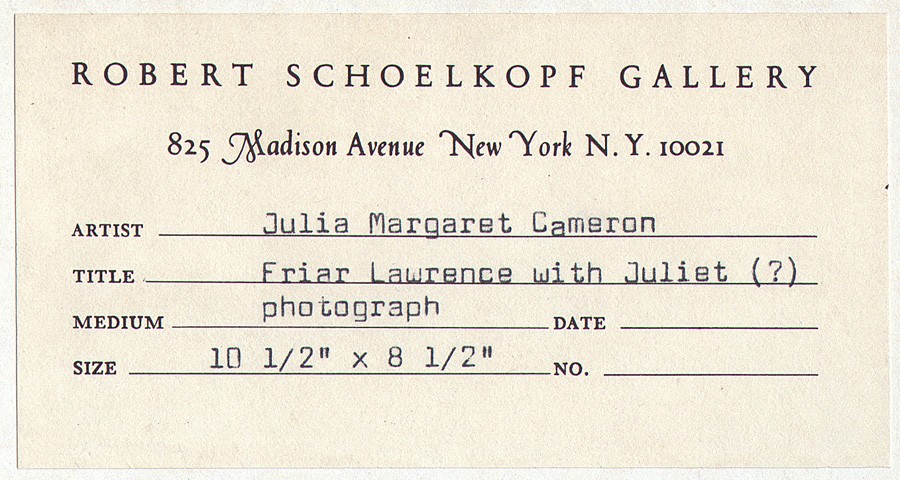 Robert Schoelkopf Gallery paper adhesive label from ca. 1965-1972 affixed to verso of mount from photograph "Friar Laurence and Juliet" : 5.8 x 11.1 cm. Formerly located at 825 Madison Ave. in New York City, the Schoelkopf gallery was established in 1962 and closed in 1991. It was one of the very first in the United States to present photography as a fine art and by the Spring of 1974, had "opened a gallery dedicated to photography on the second floor" of this address. from: PhotoSeed Archive
Robert Schoelkopf Gallery paper adhesive label from ca. 1965-1972 affixed to verso of mount from photograph "Friar Laurence and Juliet" : 5.8 x 11.1 cm. Formerly located at 825 Madison Ave. in New York City, the Schoelkopf gallery was established in 1962 and closed in 1991. It was one of the very first in the United States to present photography as a fine art and by the Spring of 1974, had "opened a gallery dedicated to photography on the second floor" of this address. from: PhotoSeed Archive
Other treasures await additional scholarship. For our part, PhotoSeed presents with this post a seldom-seen work by Cameron formerly owned by Peter Hukill, (1927-2003) an early collector of fine art photography who built a collection thanks to the early efforts of galleries including the former Robert Schoelkopf Gallery in New York City, the records of which now reside in the Smithsonian Archives of American Art.
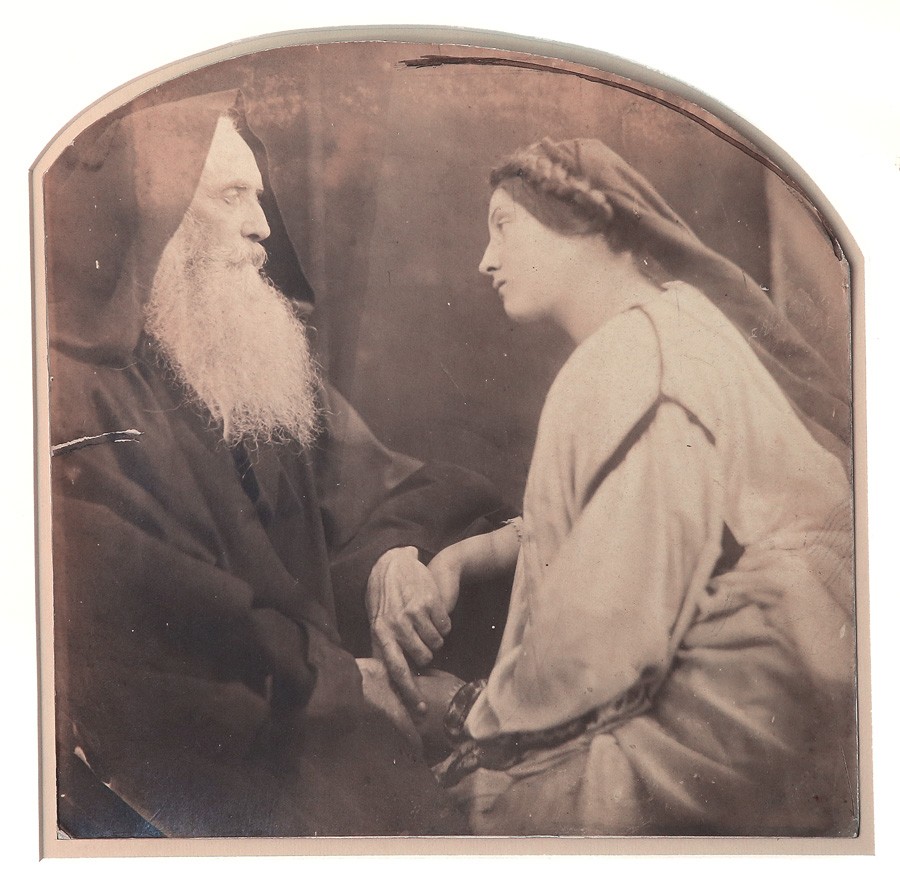 "Friar Laurence and Juliet", by Julia Margaret Cameron: copyrighted Nov. 11, 1865. Three separate versions of this title exist as recorded in Julia Margaret Cameron: The Complete Photographs. (Cox & Ford) This version with model Mary Hillier- Cameron's personal maid- wearing lighter-colored topcoat posing with Henry Taylor. (C&F #1089) Vintage albumen silver print mounted separately on board presented within window of modern mount. Condition of print exhibits uneven arched top with free-hand drawn ink line near top margin and surface marks to print emulsion. image: 28.2 x 28.6 cm | mount: 60.7 x 50.7 cm. photograph placed at auction by Robert Schoelkopf Gallery in 1972 (Parke-Bernet) and acquired by Peter Hukill. from: PhotoSeed Archive
"Friar Laurence and Juliet", by Julia Margaret Cameron: copyrighted Nov. 11, 1865. Three separate versions of this title exist as recorded in Julia Margaret Cameron: The Complete Photographs. (Cox & Ford) This version with model Mary Hillier- Cameron's personal maid- wearing lighter-colored topcoat posing with Henry Taylor. (C&F #1089) Vintage albumen silver print mounted separately on board presented within window of modern mount. Condition of print exhibits uneven arched top with free-hand drawn ink line near top margin and surface marks to print emulsion. image: 28.2 x 28.6 cm | mount: 60.7 x 50.7 cm. photograph placed at auction by Robert Schoelkopf Gallery in 1972 (Parke-Bernet) and acquired by Peter Hukill. from: PhotoSeed Archive
Prescient, and subversive indeed. The Schoelkopf Gallery was apparently one of the first to feature photography as fine art in the United States. In 1967, it had the distinction of mounting the last solo show of Cameron’s work before the Met’s which opened in 2013: “timing it to coincide with a show at the Metropolitan Museum of Art that focused on Cameron as one of four Victorian photographers.” (1.)
1. excerpt: Robert Schoelkopf Gallery records, 1851-1991: Smithsonian Archives of American Art online resource: “In its early years the Robert Schoelkopf Gallery contributed considerably to the development of interest in fine art photography that fostered an increasingly lucrative market for photographic prints during the 1960s and 1970s.”
March of Trade's Harmonious Shades
Posted November 2012 in Advertising, History of Photography, Journals, Publishing
The Photographic Times (1871-1915) was one of America’s earliest and most important photographic journals. By 1880, its publisher declared it the highest circulating magazine of its type in the country and by December of 1893, the first edition was stated to be 5,000 copies a week, an extraordinary number considering the inclusion by that time of a hand-pulled photogravure or collotype frontis plate. As a researcher, it would be presumptuous of me to think it possible in the modern day to present a fully-formed history of this publication without more direct corroboration from those who made that history. But since those folks are all dead, someone had to take a stab at it.
 1871-1873: The Photographic Times was first published by The Scovill Manufacturing Company, which maintained offices in this building at 36 Park Row and 4 Beekman streets in lower Manhattan. Completed in 1857 and known as the Potter or World Building, it was the home of the New York World newspaper offices and many other publications. (an adjoining building for The New York Times is at far left of frame) The sign for the Scovill Manufacturing Co. has been highlighted in red for clarity on the Park Row side. Since rebuilt, this building and block was destroyed by a massive fire on January 31, 1882 that claimed 12 lives. This detail from a circa 1870 stereoscopic view in the collection of the New York Public Library: Image ID: G91F211_034F
1871-1873: The Photographic Times was first published by The Scovill Manufacturing Company, which maintained offices in this building at 36 Park Row and 4 Beekman streets in lower Manhattan. Completed in 1857 and known as the Potter or World Building, it was the home of the New York World newspaper offices and many other publications. (an adjoining building for The New York Times is at far left of frame) The sign for the Scovill Manufacturing Co. has been highlighted in red for clarity on the Park Row side. Since rebuilt, this building and block was destroyed by a massive fire on January 31, 1882 that claimed 12 lives. This detail from a circa 1870 stereoscopic view in the collection of the New York Public Library: Image ID: G91F211_034F
Besides the written record, the important legacy left by the journal in my estimation are its hand-pulled photogravure plates which appeared regularly from 1889-1904, the latter being included in the combined but short-lived publication The Photographic Times-Bulletin. As a collector of this material for many years, it is surprising to me how little seems to have survived given the large circulation of the Times. My overview of the publication, which appears here in PhotoSeed Highlights, might very well put you to sleep due to length, or perhaps not. In tracing the history of this journal, my journey of discovery made me realize a fact of interest to all photographers, especially with respect to the United States: the first publisher of the Times, the Scovill Manufacturing Company of New York City, with a large factory complex in Waterbury, CT, was largely responsible for the birth and progress of photographic commerce in 19th century America.
 1871-1915 timeline: The Scovill company, publishers of The Photographic Times, did business at 9 different locations in New York City over 45 years. This Google street map with inset address key covers a walking distance today of approximately 4.6 miles. Arranged chronologically from A-I, the dates and addresses for the company are as follows: 1871-1873: 4 Beekman Street 1874-1884: 419-421 Broome Street 1884-1895: 423 Broome Street 1896-1900: 60-62 East 11th Street 1900 (Fall)-1902: 3-5 West 19th Street April 1902-1903: 122-124 Fifth Ave. 1904: 75-77 Eighth Ave. December, 1904-1908: 39 Union Square West 1909-1915: 135 West 14th Street
1871-1915 timeline: The Scovill company, publishers of The Photographic Times, did business at 9 different locations in New York City over 45 years. This Google street map with inset address key covers a walking distance today of approximately 4.6 miles. Arranged chronologically from A-I, the dates and addresses for the company are as follows: 1871-1873: 4 Beekman Street 1874-1884: 419-421 Broome Street 1884-1895: 423 Broome Street 1896-1900: 60-62 East 11th Street 1900 (Fall)-1902: 3-5 West 19th Street April 1902-1903: 122-124 Fifth Ave. 1904: 75-77 Eighth Ave. December, 1904-1908: 39 Union Square West 1909-1915: 135 West 14th Street
The following visual timeline is my attempt to show off the look of the publication over the 45 years it existed under its own imprint along with the principal men involved in editing it- part of the Photographic Times Publishing Association, one of the many business interests of the parent company. During this time, Scovill’s march of trade on the island of Manhattan involved eight separate business moves over a walkable distance today of roughly 4.6 miles. To this end, part of the mission statement issued by the Time’s editors to its many readers- from post American Civil War beginnings in January, 1871 to its 1915 demise remained true over the life of the journal:
we shall intersperse here and there delicate half-tones and harmonious shades from sources of information which shall do you good service in your manipulations, and add to your store of useful knowledge. We have engaged talent for this end, which is competent and able to instruct.
-David Spencer November, 2012
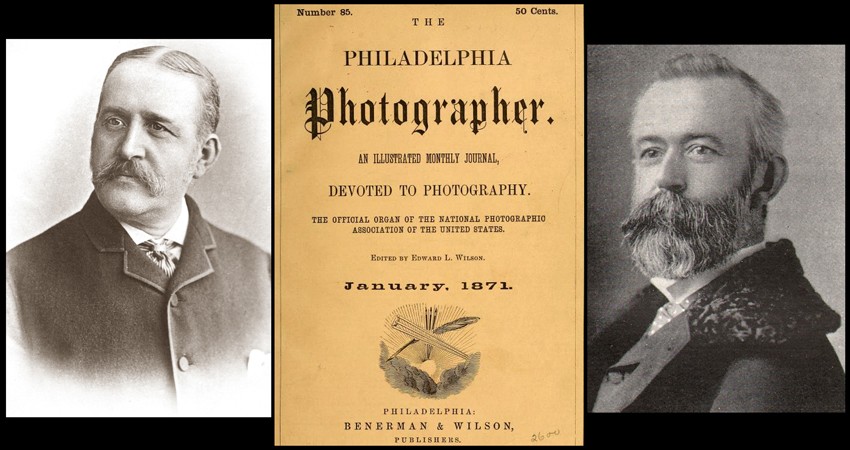 1870: The Times first appeared as a supplement incorporated within the pages of the monthly Philadelphia Photographer, center, one of the first journals devoted to photography published in America beginning in 1864. Washington Irving Adams, left, (1832-1896) came up with the idea for the Times during a working lunch attended in 1869 by men associated with the Scovill Manufacturing Company. Edward Wilson, right, (1838-1903) was the founder, editor and publisher of the Philadelphia Photographer, as well as good friend to Adams. Photo credits: portraits: PhotoSeed Archive; magazine cover: HathiTrust
1870: The Times first appeared as a supplement incorporated within the pages of the monthly Philadelphia Photographer, center, one of the first journals devoted to photography published in America beginning in 1864. Washington Irving Adams, left, (1832-1896) came up with the idea for the Times during a working lunch attended in 1869 by men associated with the Scovill Manufacturing Company. Edward Wilson, right, (1838-1903) was the founder, editor and publisher of the Philadelphia Photographer, as well as good friend to Adams. Photo credits: portraits: PhotoSeed Archive; magazine cover: HathiTrust
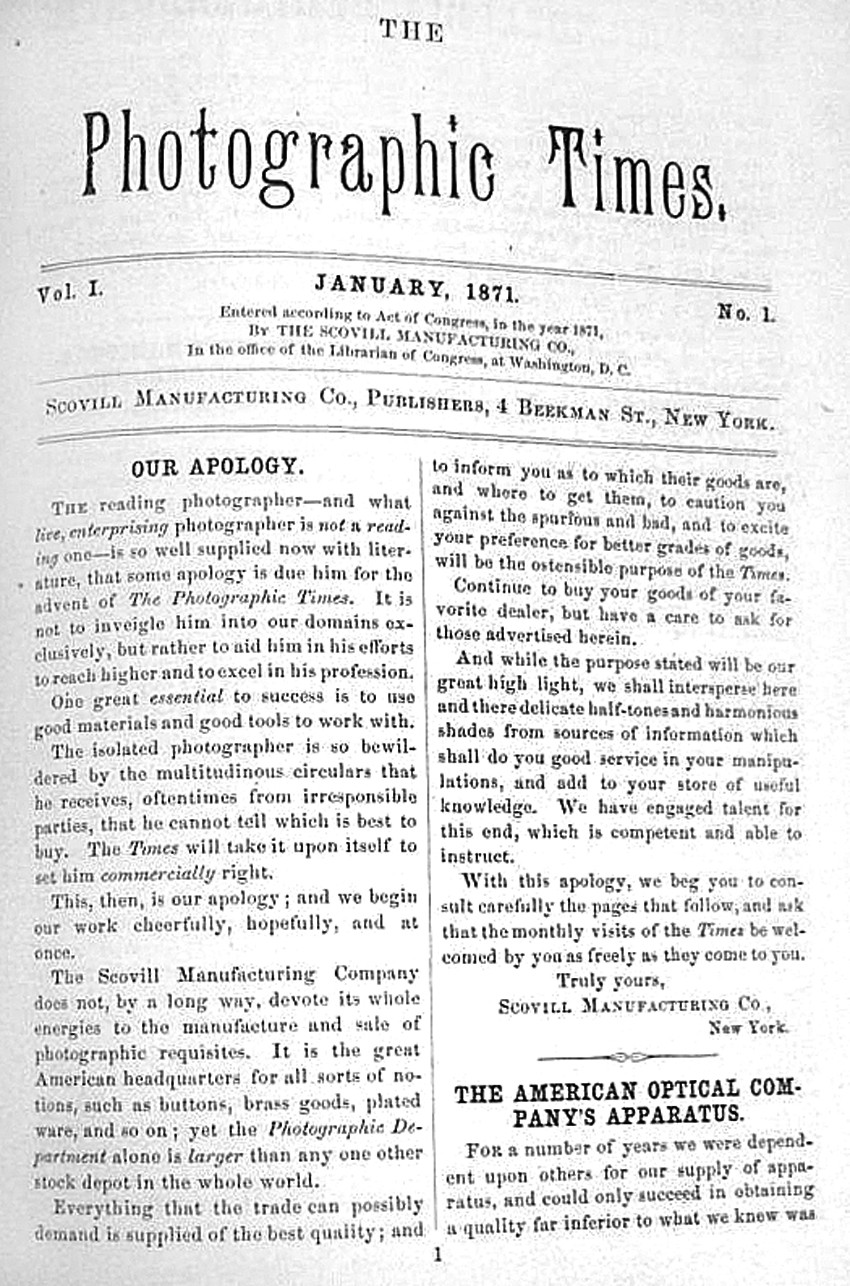 1871: The Photographic Times appeared for the first time under the imprint of the Scovill Manufacturing Company of 4 Beekman street in New York City beginning with the January, 1871 issue. The first page of the eight-page trade monthly included an "Apology", intended to "set the photographer commercially right.” It was sent out free of charge with Wilson's Philadelphia Photographer, The Photographic World, and Walzl’s Photographic Magazine, along with an additional 500 copies mailed each month from Scovill's New York offices. Photo credit: D. Richards, Bookman: Pittsburgh, PA
1871: The Photographic Times appeared for the first time under the imprint of the Scovill Manufacturing Company of 4 Beekman street in New York City beginning with the January, 1871 issue. The first page of the eight-page trade monthly included an "Apology", intended to "set the photographer commercially right.” It was sent out free of charge with Wilson's Philadelphia Photographer, The Photographic World, and Walzl’s Photographic Magazine, along with an additional 500 copies mailed each month from Scovill's New York offices. Photo credit: D. Richards, Bookman: Pittsburgh, PA
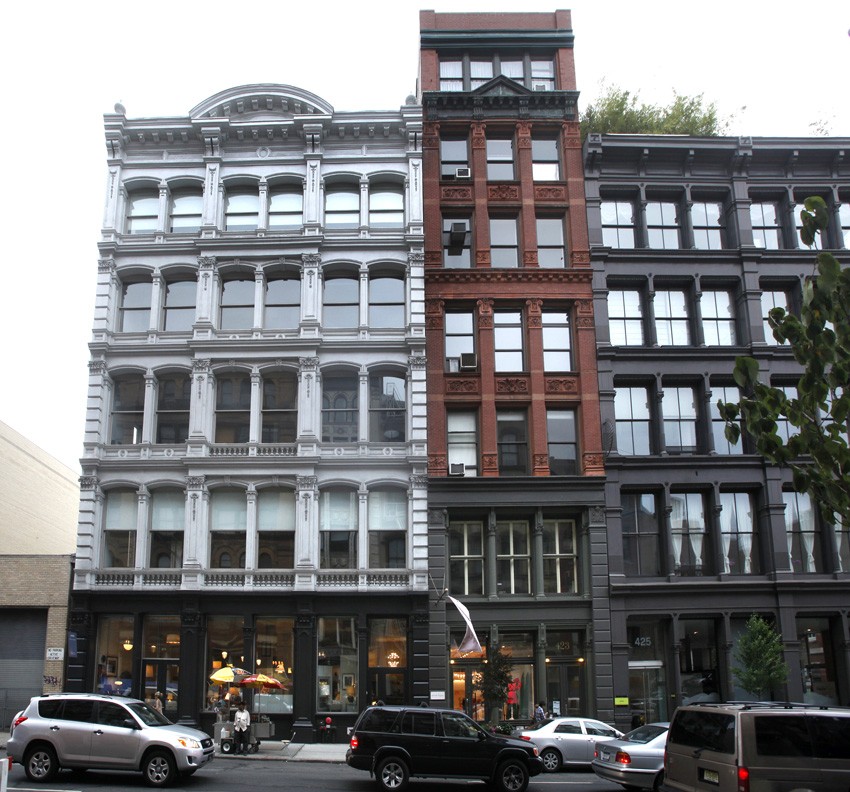 1874 | 1884: Because of "want of room and the march of trade", the Scovill company had moved to new quarters at 419-421 Broome street by January, 1874. Located in SoHo, the building as it stands today can be seen at left in a photograph taken in June, 2012. By May of 1884, another move for the Times and the Scovill company took place right next door: the building at center with the address of 423 Broome Street, built for the company by architectural firm D. & J. Jardine. Described as a warehouse building at the time, Times editor Washington Irving Adams commented on its many benefits: "This well appointed structure, embracing seven floors and a double basement, we have erected to meet the special requirements of our business. The building, with its improved interior arrangements, will greatly enlarge our facilities and enable us to respond to the wants of our patrons in a more expeditious and satisfactory manner than heretofore. For the accommodation of our friends, a well-constructed dark-room and sky-light have been added to the many other conveniences introduced, all of which will subserve in various ways the interests of our customers." PhotoSeed Archive photograph by David Spencer
1874 | 1884: Because of "want of room and the march of trade", the Scovill company had moved to new quarters at 419-421 Broome street by January, 1874. Located in SoHo, the building as it stands today can be seen at left in a photograph taken in June, 2012. By May of 1884, another move for the Times and the Scovill company took place right next door: the building at center with the address of 423 Broome Street, built for the company by architectural firm D. & J. Jardine. Described as a warehouse building at the time, Times editor Washington Irving Adams commented on its many benefits: "This well appointed structure, embracing seven floors and a double basement, we have erected to meet the special requirements of our business. The building, with its improved interior arrangements, will greatly enlarge our facilities and enable us to respond to the wants of our patrons in a more expeditious and satisfactory manner than heretofore. For the accommodation of our friends, a well-constructed dark-room and sky-light have been added to the many other conveniences introduced, all of which will subserve in various ways the interests of our customers." PhotoSeed Archive photograph by David Spencer
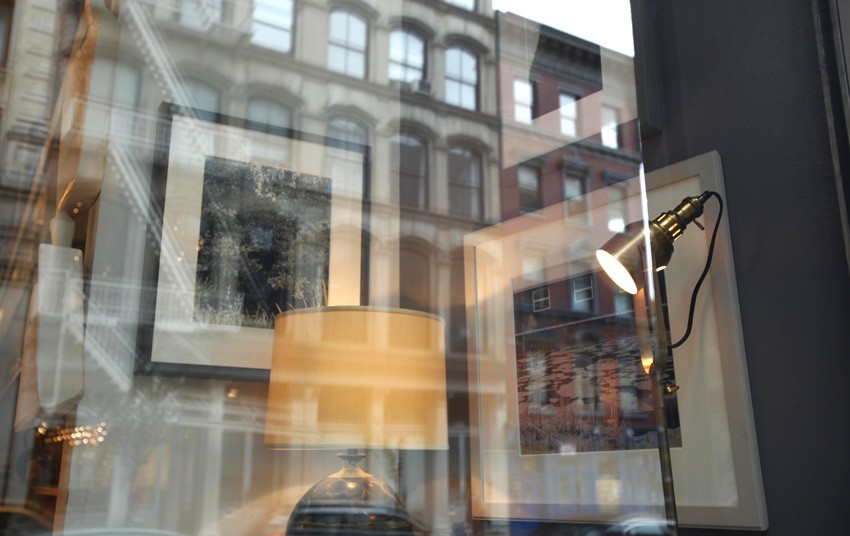 2012: Serendipity, coincidence or both? A modern day investigator peering through the front window of 419 Broome street is startled to learn the fine art of photography is alive and well nearly 140 years after this space occupied one of the leading mouthpieces of the photographic press. In the business space Aero LTD, a home furnishing store, professional photographer Michelle Arcila's work is framed and ready for sale. Her photographs "Present Tense" at left and "Olympia" share the reflected outside world of Broome street. PhotoSeed Archive photograph by David Spencer
2012: Serendipity, coincidence or both? A modern day investigator peering through the front window of 419 Broome street is startled to learn the fine art of photography is alive and well nearly 140 years after this space occupied one of the leading mouthpieces of the photographic press. In the business space Aero LTD, a home furnishing store, professional photographer Michelle Arcila's work is framed and ready for sale. Her photographs "Present Tense" at left and "Olympia" share the reflected outside world of Broome street. PhotoSeed Archive photograph by David Spencer
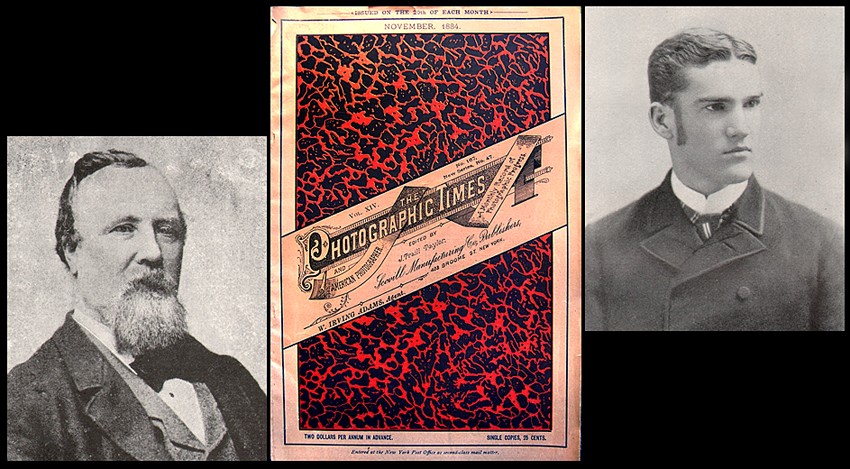 1881 | 1884 | 1885: Beginning in 1881, a new editorial direction was brought to the Times, renamed The Photographic Times and American Photographer, by Englishman John Traill Taylor, (1827-1895) left. A veteran of the British Journal of Photography, he was eventually succeeded as editor by Washington Irving Lincoln Adams, (1865-1946) right, son of the journal's founder, joining the editorial staff in 1885. At center is a rare surviving example of a Times cover from November, 1884. Photo credits: portraits: PhotoSeed Archive; magazine cover: Ebay
1881 | 1884 | 1885: Beginning in 1881, a new editorial direction was brought to the Times, renamed The Photographic Times and American Photographer, by Englishman John Traill Taylor, (1827-1895) left. A veteran of the British Journal of Photography, he was eventually succeeded as editor by Washington Irving Lincoln Adams, (1865-1946) right, son of the journal's founder, joining the editorial staff in 1885. At center is a rare surviving example of a Times cover from November, 1884. Photo credits: portraits: PhotoSeed Archive; magazine cover: Ebay
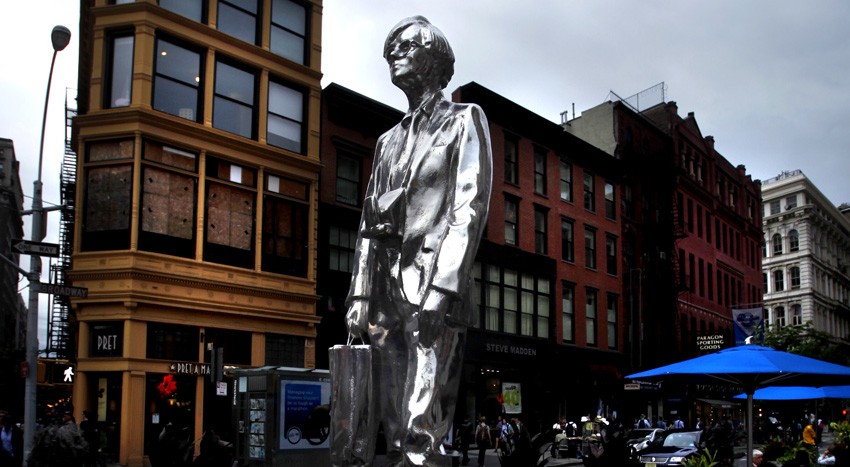 2012: Besides being the king of Pop art, Andy Warhol (1928-1987) was also a passionate photographer, going everywhere with his Polaroid camera-seen here around his neck in the famous (since removed) chrome-plated "Andy Monument" by sculptor Rob Pruitt in Union Square. A parallel or association with the Photographic Times? You bet. Albeit sixty years later, Warhol’s second "Silver Factory" was established in 1968 and located around the corner from the statue at 33 Union Square West, just three doors down from 39 Union Square, one of the last home offices for the Times from 1904-1908. PhotoSeed Archive photograph (June) by David Spencer
2012: Besides being the king of Pop art, Andy Warhol (1928-1987) was also a passionate photographer, going everywhere with his Polaroid camera-seen here around his neck in the famous (since removed) chrome-plated "Andy Monument" by sculptor Rob Pruitt in Union Square. A parallel or association with the Photographic Times? You bet. Albeit sixty years later, Warhol’s second "Silver Factory" was established in 1968 and located around the corner from the statue at 33 Union Square West, just three doors down from 39 Union Square, one of the last home offices for the Times from 1904-1908. PhotoSeed Archive photograph (June) by David Spencer
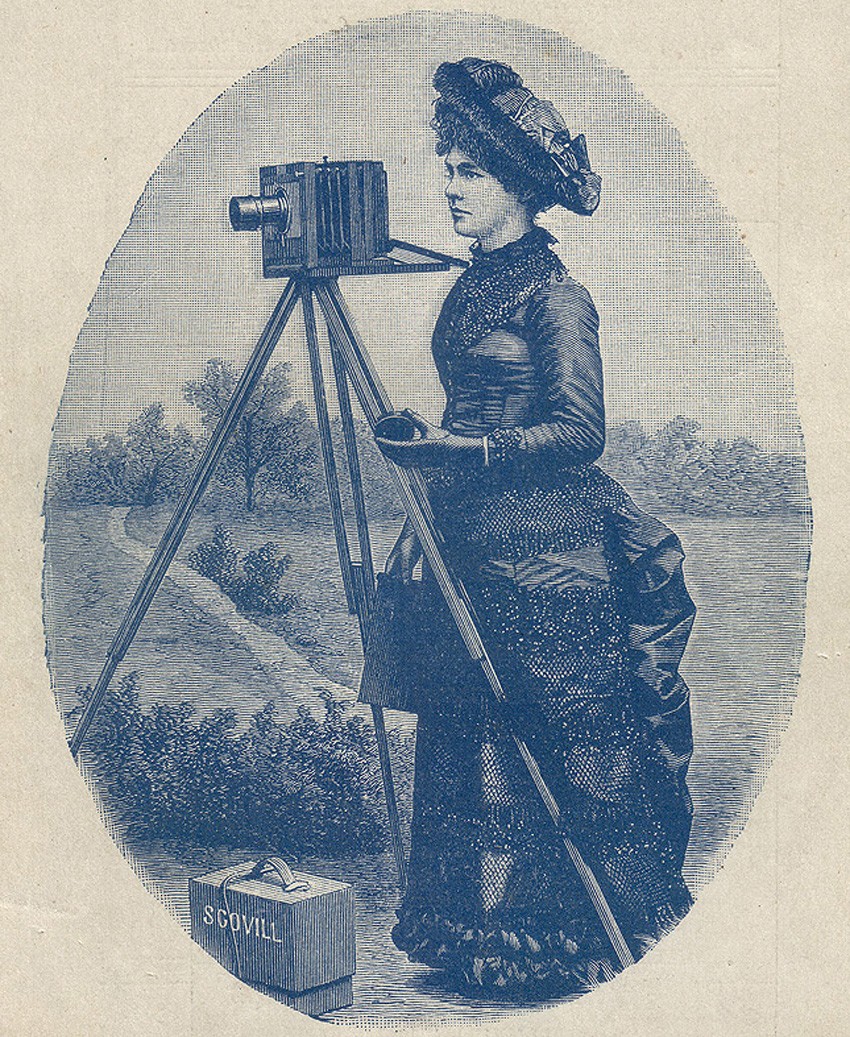 1883: With modern dry gelatin photographic plates replacing the cumbersome wet plate (collodion) process around 1881, the Scovill company through their publications including the Photographic Times began marketing in earnest complete and affordable amateur outfits to the masses. This fashionably dressed lady amateur, appearing as early as 1883 as a wood engraving in Scovill's catalogue: "How to Make Photographs", advertised their "Amateur Photographic Requisites". For the grand sum of $10.00, a photographer could obtain "Favorite Outfit A": an adjustable 4 x 5 Scovill plate camera, "Waterbury" achromatic nickel plated lens, a Taylor folding tripod, a double dry plate holder for the camera and carrying case. After becoming the Scovill & Adams company in 1889, the firm developed other popular mass market cameras including the Henry Clay and Solograph models as well as many others. 1889 engraving from Scovill catalogue courtesy of Larry Pierce.
1883: With modern dry gelatin photographic plates replacing the cumbersome wet plate (collodion) process around 1881, the Scovill company through their publications including the Photographic Times began marketing in earnest complete and affordable amateur outfits to the masses. This fashionably dressed lady amateur, appearing as early as 1883 as a wood engraving in Scovill's catalogue: "How to Make Photographs", advertised their "Amateur Photographic Requisites". For the grand sum of $10.00, a photographer could obtain "Favorite Outfit A": an adjustable 4 x 5 Scovill plate camera, "Waterbury" achromatic nickel plated lens, a Taylor folding tripod, a double dry plate holder for the camera and carrying case. After becoming the Scovill & Adams company in 1889, the firm developed other popular mass market cameras including the Henry Clay and Solograph models as well as many others. 1889 engraving from Scovill catalogue courtesy of Larry Pierce.
 1886: Dr. Charles Ehrmann, (1822-1894) a pharmaceutical chemist by training at the University of Berlin, joined the Photographic Times as an assistant editor under John Traill Taylor beginning in 1881. His obituary penned by Frederick Beach in the American Amateur Photographer said he became the "guiding editorial spirit" for the Times after Taylor's retirement in 1886, even under Lincoln Adams, and was the journal's "chief experimentalist- investigating and writing in the pages of the Times the myriad processes then used in traditional wet darkroom photography. In the Fall of 1886, Ehrmann was named instructor in the newly established Chautauqua University School of Photography, chiefly a correspondence school, but also one where he gave hands-on instruction in photography with diplomas awarded from the summer home in upstate New York as well as the Broome street offices of the Times. This photograph of Ehrmann appeared as a full-page plate in the May 25, 1888 issue of the Times. Photo credit: HathiTrust
1886: Dr. Charles Ehrmann, (1822-1894) a pharmaceutical chemist by training at the University of Berlin, joined the Photographic Times as an assistant editor under John Traill Taylor beginning in 1881. His obituary penned by Frederick Beach in the American Amateur Photographer said he became the "guiding editorial spirit" for the Times after Taylor's retirement in 1886, even under Lincoln Adams, and was the journal's "chief experimentalist- investigating and writing in the pages of the Times the myriad processes then used in traditional wet darkroom photography. In the Fall of 1886, Ehrmann was named instructor in the newly established Chautauqua University School of Photography, chiefly a correspondence school, but also one where he gave hands-on instruction in photography with diplomas awarded from the summer home in upstate New York as well as the Broome street offices of the Times. This photograph of Ehrmann appeared as a full-page plate in the May 25, 1888 issue of the Times. Photo credit: HathiTrust
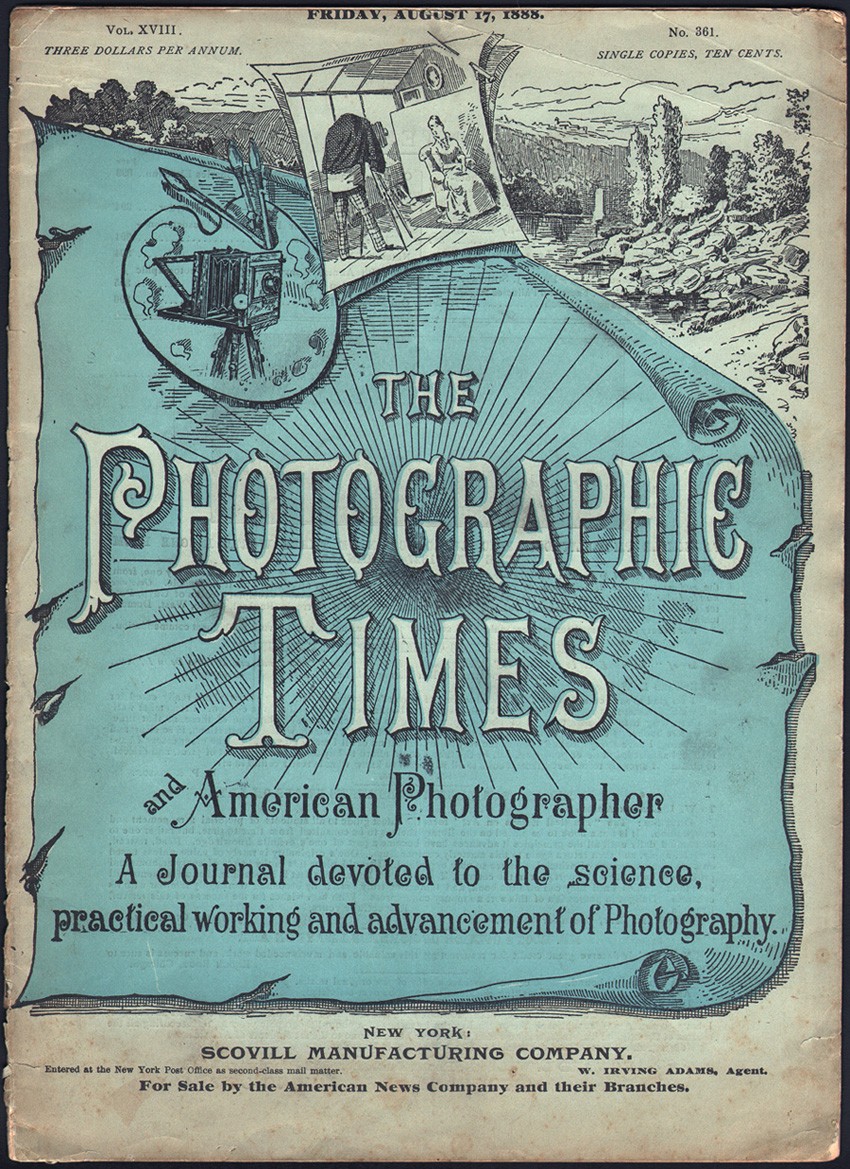 1887-1888: This is an example of a cover from The Photographic Times and American Photographer dated Friday, August 17, 1888. This was the same design used for the journal in 1887. (unknown if it was used before 1887) The quarto format journal was printed in blue and black with the artwork possibly being by the hand of Brooklyn artist William Mozart. From: PhotoSeed Archive
1887-1888: This is an example of a cover from The Photographic Times and American Photographer dated Friday, August 17, 1888. This was the same design used for the journal in 1887. (unknown if it was used before 1887) The quarto format journal was printed in blue and black with the artwork possibly being by the hand of Brooklyn artist William Mozart. From: PhotoSeed Archive
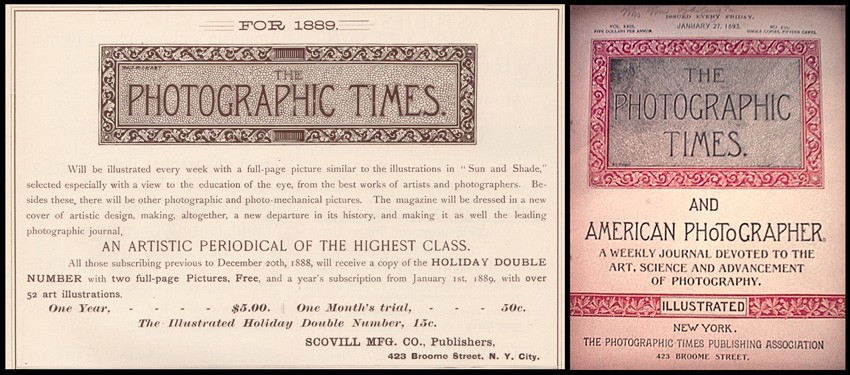 1889: This year brought a complete redesign to the look of the Times. Brooklyn artist and photographer William J. Mozart, (b. 1855) who had honed his skill first as a scene painter at a Boston museum beginning in 1878 came up with the logo seen here at left, incorporated within a January, 1889 advertisement for the Times in the periodical Sun and Shade. "The magazine will be dressed in a new cover of artistic design, making, altogether, a new departure in its history, and making it as well the leading photographic journal." The weekly would also for the first time feature in every issue a full-page illustration, typically a photogravure or fine process collotype. At right is an example of the new cover by Mozart. (this issue from January, 1893). Advertisement from PhotoSeed Archive; cover: Crown Antiques & Collectible
1889: This year brought a complete redesign to the look of the Times. Brooklyn artist and photographer William J. Mozart, (b. 1855) who had honed his skill first as a scene painter at a Boston museum beginning in 1878 came up with the logo seen here at left, incorporated within a January, 1889 advertisement for the Times in the periodical Sun and Shade. "The magazine will be dressed in a new cover of artistic design, making, altogether, a new departure in its history, and making it as well the leading photographic journal." The weekly would also for the first time feature in every issue a full-page illustration, typically a photogravure or fine process collotype. At right is an example of the new cover by Mozart. (this issue from January, 1893). Advertisement from PhotoSeed Archive; cover: Crown Antiques & Collectible
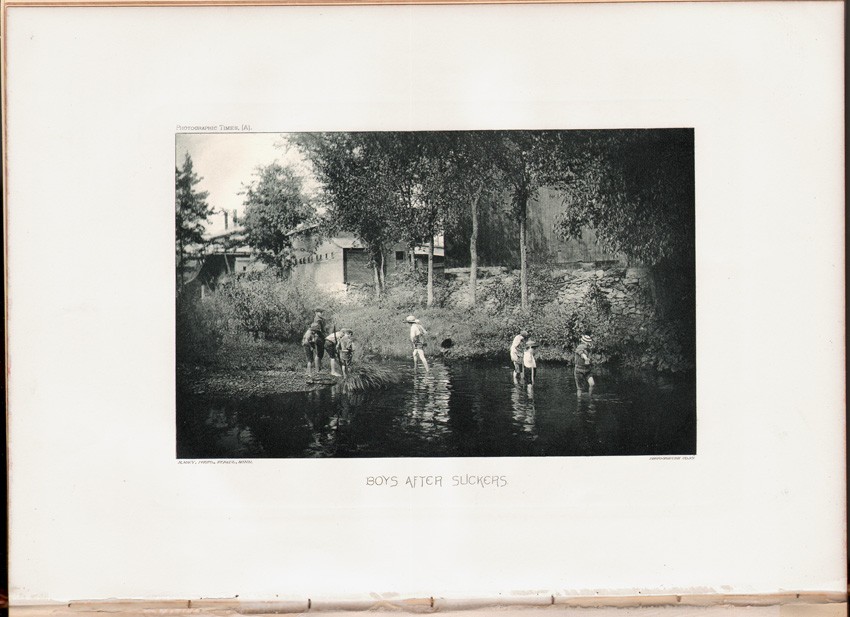 1889: "Boys after Suckers" by Minnesota photographer Rev. Herbert Macy, was the photogravure frontis plate for the April 18, 1890 weekly issue of the Times. Image: 11.2 x 17.9 cm | Support: 20.5 x 28.7 cm Photogravures such as these were a major selling point for potential subscribers, with the cost of a yearly subscription being $5.00. In 1893, the editors wrote: "The PHOTOGRAPHIC TIMES had frequently brought out full-page pictorial illustrations, in addition to the cuts and diagrams which always brightened its reading columns; but beginning with 1889, it presented its readers regularly, each week, with a full-page pictorial frontispiece, reproduced by photogravure or other high grade process, and including an occasional photographic print on albumen or other sensitive paper. It thus became the first and continues to be the only photographic weekly publication in the world, containing a full-page picture with every issue." Photo: PhotoSeed Archive
1889: "Boys after Suckers" by Minnesota photographer Rev. Herbert Macy, was the photogravure frontis plate for the April 18, 1890 weekly issue of the Times. Image: 11.2 x 17.9 cm | Support: 20.5 x 28.7 cm Photogravures such as these were a major selling point for potential subscribers, with the cost of a yearly subscription being $5.00. In 1893, the editors wrote: "The PHOTOGRAPHIC TIMES had frequently brought out full-page pictorial illustrations, in addition to the cuts and diagrams which always brightened its reading columns; but beginning with 1889, it presented its readers regularly, each week, with a full-page pictorial frontispiece, reproduced by photogravure or other high grade process, and including an occasional photographic print on albumen or other sensitive paper. It thus became the first and continues to be the only photographic weekly publication in the world, containing a full-page picture with every issue." Photo: PhotoSeed Archive
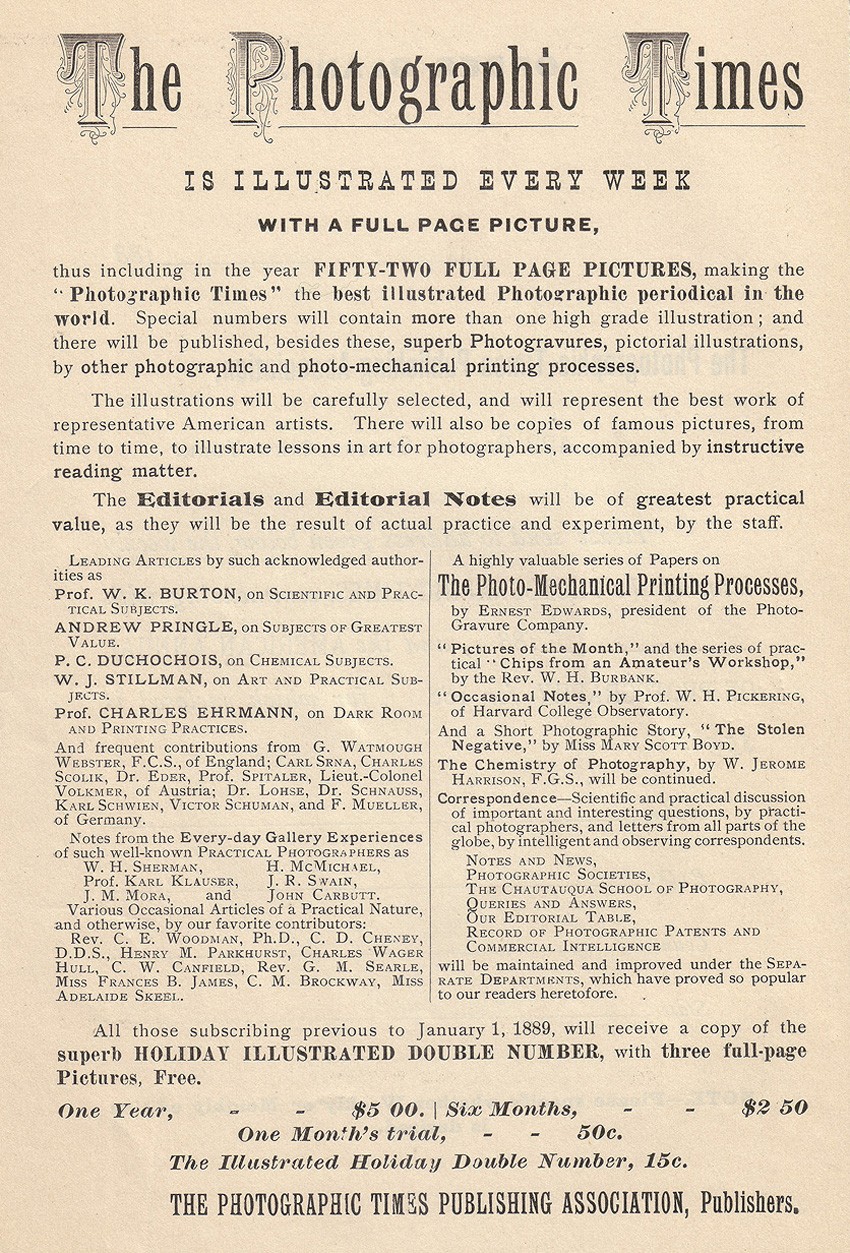 1889: With its new emphasis on high-grade illustrations that would be reproduced each week, other particulars and selling points, including the following quote, appeared in the 1889 Scovill & Adams company trade brochure "How to Make Photographs" : "The Editorials and Editorial Notes will be of greatest practical value, as they will be the result of actual practice and experiment, by the staff." Advertisement courtesy of Larry Pierce.
1889: With its new emphasis on high-grade illustrations that would be reproduced each week, other particulars and selling points, including the following quote, appeared in the 1889 Scovill & Adams company trade brochure "How to Make Photographs" : "The Editorials and Editorial Notes will be of greatest practical value, as they will be the result of actual practice and experiment, by the staff." Advertisement courtesy of Larry Pierce.
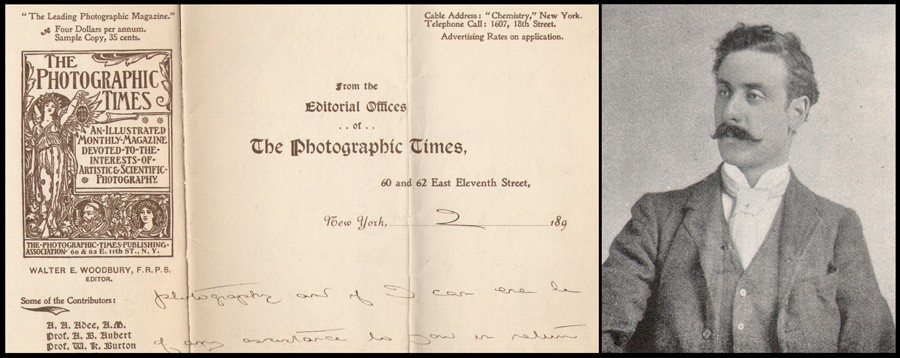 1893: In the Spring of this year, Walter Edward Woodbury, (1865-1905) seen at right around this time, joined the editorial staff of the Times, and before the end of 1894 was appointed editor by Lincoln Adams. A Fellow of the Royal Photographic Society and son of Englishman Walter Bentley Woodbury, (1834-1885) he oversaw major changes to the Times, including its transformation to a monthly and into a “high-class art magazine”. Perhaps the most noticeable change of this last aspect for a subscriber was the dramatic new cover design featuring Roman goddess Veritas holding out her lamp symbolically lighting the way for truth, designed by English bookplate artist George Richard Quested. The design was even incorporated into Woodbury's personalized Times letterhead, a detail of which can be seen here. Letterhead and portrait: PhotoSeed Archive
1893: In the Spring of this year, Walter Edward Woodbury, (1865-1905) seen at right around this time, joined the editorial staff of the Times, and before the end of 1894 was appointed editor by Lincoln Adams. A Fellow of the Royal Photographic Society and son of Englishman Walter Bentley Woodbury, (1834-1885) he oversaw major changes to the Times, including its transformation to a monthly and into a “high-class art magazine”. Perhaps the most noticeable change of this last aspect for a subscriber was the dramatic new cover design featuring Roman goddess Veritas holding out her lamp symbolically lighting the way for truth, designed by English bookplate artist George Richard Quested. The design was even incorporated into Woodbury's personalized Times letterhead, a detail of which can be seen here. Letterhead and portrait: PhotoSeed Archive
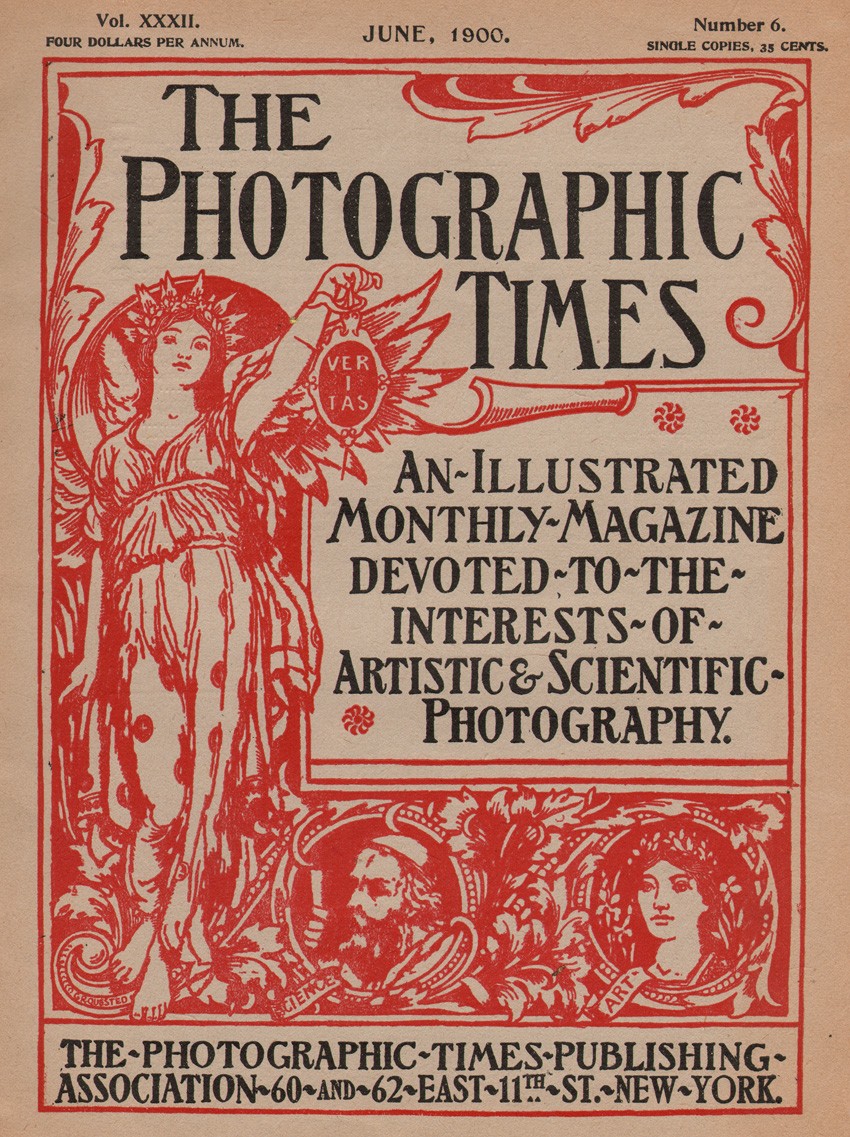 1895: The Veritas cover by Quested first used beginning in 1895 lasted through 1901, albeit in a smaller format that year. Printed in bold red ink, his design additionally featured inset portrait medallions of Science, represented by a bearded gentleman, and Art, by a fair maiden crowned by laurels. The previous weekly cover had stated: "A weekly journal devoted to the art, science and advancement of Photography" and the new monthly stated: "An illustrated monthly magazine devoted to the interests of Artistic & Scientific Photography." Sizes for cover- 1895-1900: (detail here eliminating part of borders) 29.3 x 22.5 cm; 1901: 25.0 x 17.5 cm. Cover, June, 1900: PhotoSeed Archive
1895: The Veritas cover by Quested first used beginning in 1895 lasted through 1901, albeit in a smaller format that year. Printed in bold red ink, his design additionally featured inset portrait medallions of Science, represented by a bearded gentleman, and Art, by a fair maiden crowned by laurels. The previous weekly cover had stated: "A weekly journal devoted to the art, science and advancement of Photography" and the new monthly stated: "An illustrated monthly magazine devoted to the interests of Artistic & Scientific Photography." Sizes for cover- 1895-1900: (detail here eliminating part of borders) 29.3 x 22.5 cm; 1901: 25.0 x 17.5 cm. Cover, June, 1900: PhotoSeed Archive
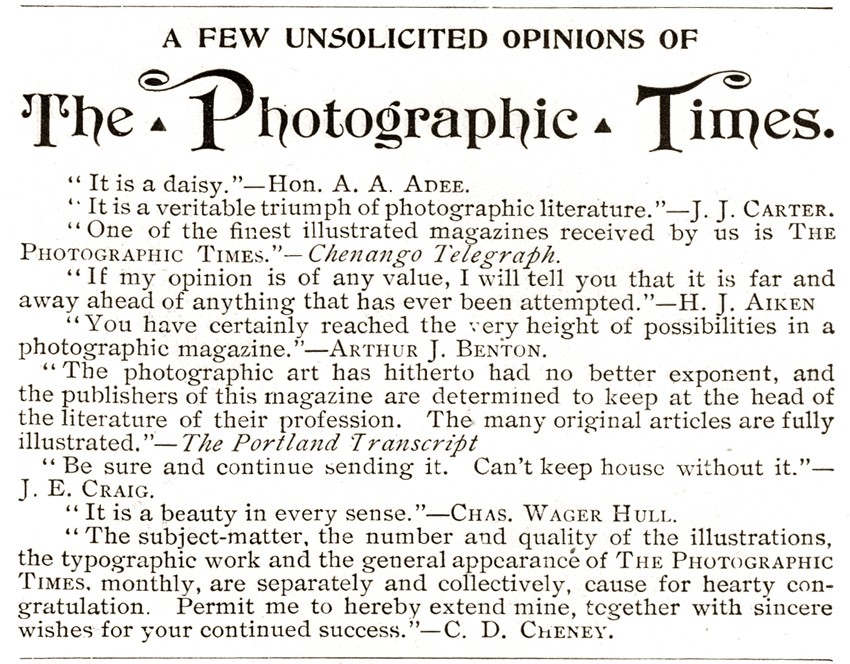 1896: Over-the-top reviews appeared frequently in various publications published by the Scovill & Adams firm in praise of the Times. One very widely-circulated volume for these praises was their annual published since 1887 titled “The American Annual of Photography and Photographic Times Almanac”, a compendium that had attained a circulation of over 20,000 copies by 1894. This advertisement of "unsolicited opinions" appeared in the advertising section of the 1896 annual. From: PhotoSeed Archive
1896: Over-the-top reviews appeared frequently in various publications published by the Scovill & Adams firm in praise of the Times. One very widely-circulated volume for these praises was their annual published since 1887 titled “The American Annual of Photography and Photographic Times Almanac”, a compendium that had attained a circulation of over 20,000 copies by 1894. This advertisement of "unsolicited opinions" appeared in the advertising section of the 1896 annual. From: PhotoSeed Archive
 1896 | 2012: As stated early in this post, the Scovill company, known since 1889 as Scovill & Adams, moved many times on the island of Manhattan. In 1896, they vacated their headquarters at 423 Broome street and took occupancy of a brand new, seven-story building specifically built for the company off of Broadway at 60 and 62 East Eleventh Street. Seen in this artist's drawing at left published in the January, 1896 issue of the Times, the editors said: "Our New Offices will be in the same building. The editorial rooms and offices will be situated on the main floor of the building. A very complete photographic and reference library will be conveniently arranged in the editorial rooms, and on the roof will be erected a finely fitted up dark-room and skylight gallery. These will be at the disposal of all our subscribers and friends." Scovill would stay in the building until the Fall of 1900. The building, housing the company Bijan Royal Inc. on the ground floor, can be seen today at right photographed in June, 2012. PhotoSeed Archive, left; right: photograph by David Spencer
1896 | 2012: As stated early in this post, the Scovill company, known since 1889 as Scovill & Adams, moved many times on the island of Manhattan. In 1896, they vacated their headquarters at 423 Broome street and took occupancy of a brand new, seven-story building specifically built for the company off of Broadway at 60 and 62 East Eleventh Street. Seen in this artist's drawing at left published in the January, 1896 issue of the Times, the editors said: "Our New Offices will be in the same building. The editorial rooms and offices will be situated on the main floor of the building. A very complete photographic and reference library will be conveniently arranged in the editorial rooms, and on the roof will be erected a finely fitted up dark-room and skylight gallery. These will be at the disposal of all our subscribers and friends." Scovill would stay in the building until the Fall of 1900. The building, housing the company Bijan Royal Inc. on the ground floor, can be seen today at right photographed in June, 2012. PhotoSeed Archive, left; right: photograph by David Spencer
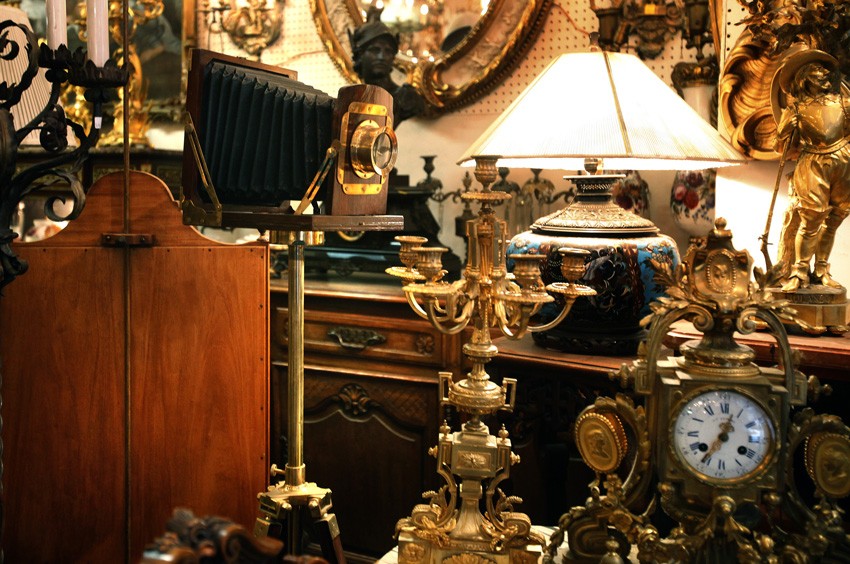 2012: More serendipity in the modern day or crazy fluke? A visit to the current first floor showroom space of antique dealer Bijan Royal at 60 East 11th street in June miraculously revealed on display this impressive looking, tripod-mounted plate camera. Quizzing a salesman produced no more details of its history however. Instead, he was keen on photo-copying the 1896 artist drawing of the building I showed him earlier while explaining my mission. Scovill & Adams in their day here made millions of dollars selling cameras like this one (even though it suspiciously appeared more ornamental than functional) as well as every conceivable photographic accessory known to man. For this space in its day formerly held one of the greatest photographic stock houses on the planet-with the Photographic Times offices in this space producing monthly the physical embodiment of the day's most important social media. PhotoSeed Archive photo by David Spencer
2012: More serendipity in the modern day or crazy fluke? A visit to the current first floor showroom space of antique dealer Bijan Royal at 60 East 11th street in June miraculously revealed on display this impressive looking, tripod-mounted plate camera. Quizzing a salesman produced no more details of its history however. Instead, he was keen on photo-copying the 1896 artist drawing of the building I showed him earlier while explaining my mission. Scovill & Adams in their day here made millions of dollars selling cameras like this one (even though it suspiciously appeared more ornamental than functional) as well as every conceivable photographic accessory known to man. For this space in its day formerly held one of the greatest photographic stock houses on the planet-with the Photographic Times offices in this space producing monthly the physical embodiment of the day's most important social media. PhotoSeed Archive photo by David Spencer
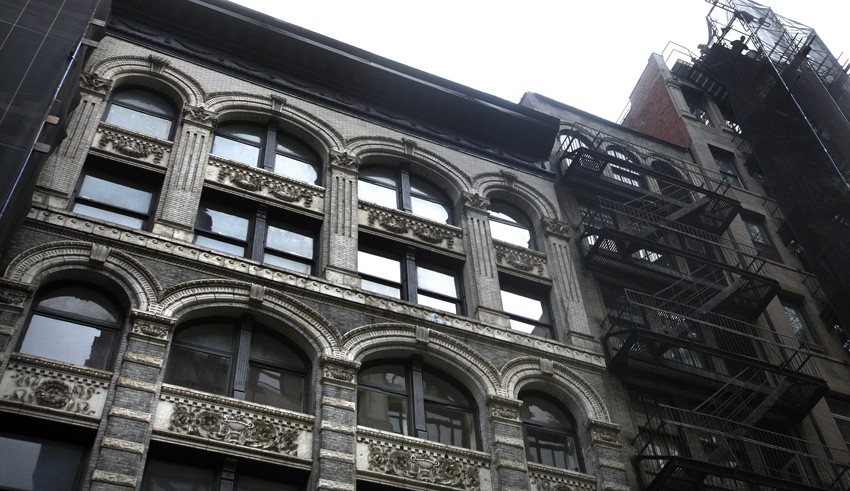 2012: A view of the facade showing the top floors of 60-62 East 11th. "The lofts will be reserved for the storage of original cases and other unpacked goods. A specially constructed dark-room for the use of their patrons and friends will be conveniently situated, and on the roof of the building there will be a commodious skylight, with light facing north, for experimental and testing purposes." During my visit, I tried my best to talk my way up to the top floor of the building to see if the skylight still existed, but to no avail. A quick search on the web indicates creative folks inhabit the seventh floor: music agency Crush Talent Management- so hooray for that. PhotoSeed Archive photo by David Spencer
2012: A view of the facade showing the top floors of 60-62 East 11th. "The lofts will be reserved for the storage of original cases and other unpacked goods. A specially constructed dark-room for the use of their patrons and friends will be conveniently situated, and on the roof of the building there will be a commodious skylight, with light facing north, for experimental and testing purposes." During my visit, I tried my best to talk my way up to the top floor of the building to see if the skylight still existed, but to no avail. A quick search on the web indicates creative folks inhabit the seventh floor: music agency Crush Talent Management- so hooray for that. PhotoSeed Archive photo by David Spencer
 1897: This extremely rare lithographic Photographic Times poster held and conserved by the Library of Congress in Washington D.C. was described in the April issue of the journal as follows: "We have had prepared for us a very attractive poster in seven colors. We give a half-tone reproduction of it herewith. Photographic dealers and newsagents will find this a valuable aid in obtaining subscriptions for this magazine. We will send one free on application and a promise that the same will be prominently displayed. The size of the poster is about 2x3 feet." Poster: Library of Congress
1897: This extremely rare lithographic Photographic Times poster held and conserved by the Library of Congress in Washington D.C. was described in the April issue of the journal as follows: "We have had prepared for us a very attractive poster in seven colors. We give a half-tone reproduction of it herewith. Photographic dealers and newsagents will find this a valuable aid in obtaining subscriptions for this magazine. We will send one free on application and a promise that the same will be prominently displayed. The size of the poster is about 2x3 feet." Poster: Library of Congress
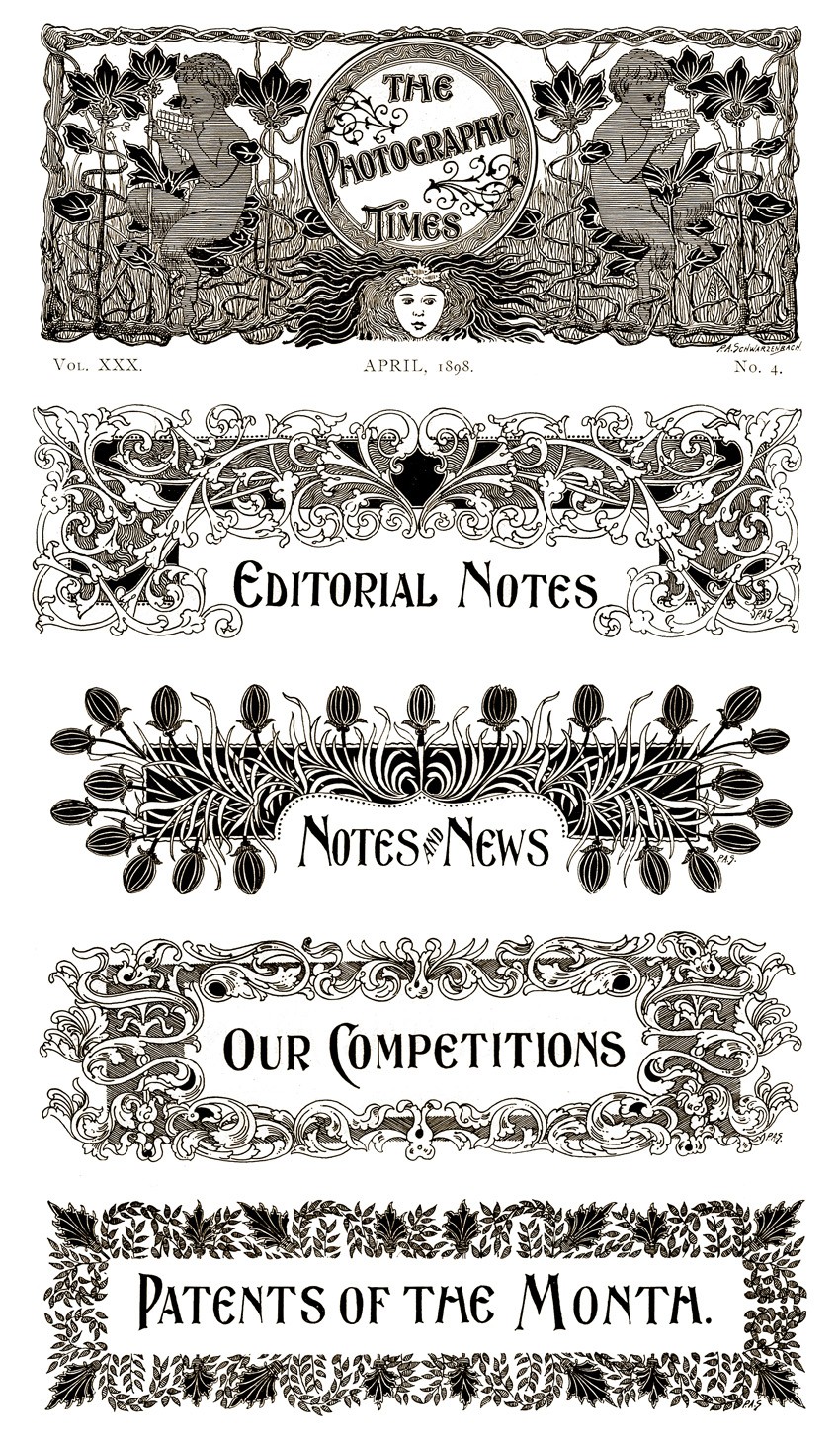 1898: In keeping with the spirit of the re-designed monthly after 1895- a "64-page artistic and scientific magazine of the very highest order" in the words of Times advertising copy from the period- illustrator P.A. Schwarzenbach supplied these decorative, Art-Nouveau inspired woodcut designs used to delineate the various departments within the editorial copy section of the journal. These specific floral designs were used during 1898 (and some before) and later into the new century. Additional Schwarzenbach designs appearing later included "Our Monthly Digest" and "The Editor's Table". Various designs, enhanced for clarity, with each approximately 6.5 x 15.5 cm ( +/-) from: PhotoSeed Archive
1898: In keeping with the spirit of the re-designed monthly after 1895- a "64-page artistic and scientific magazine of the very highest order" in the words of Times advertising copy from the period- illustrator P.A. Schwarzenbach supplied these decorative, Art-Nouveau inspired woodcut designs used to delineate the various departments within the editorial copy section of the journal. These specific floral designs were used during 1898 (and some before) and later into the new century. Additional Schwarzenbach designs appearing later included "Our Monthly Digest" and "The Editor's Table". Various designs, enhanced for clarity, with each approximately 6.5 x 15.5 cm ( +/-) from: PhotoSeed Archive
 1900: A few thoughts on Times editorial and advertising matter having to do with race. Going through old issues from the late 19th and early 20th century, I've run into that proverbial "elephant in the room" on more than one occasion: unflattering depictions of African-Americans, typically children. Through word and image, there is plenty of reason to believe this usage was not limited to mass-market American photographic journals but extended to many imprints of the era. One case in point seen here. Through modern eyes, a Times page designer going for the cheap laugh in representing monetary decision making and its potential outcomes for the amateur photographer for an article on the conundrum of photography being an affordable hobby used a series of vignettes of children stripped along the top and bottom of a page. These expressive "studies in black… and white" conveniently featured skin colors of the opposite hue for the January, 1896 article "It Costs Too Much". A mild example perhaps but one that made me wince when I first came across it. On the other hand, photographic depictions of African-Americans showing merit and historical importance do show up in the pages of the Times-even when done in the period genre style favored by American Rudolph Eickemeyer, Jr. At right, a fine example: a full-page halftone study of an elderly former slave titled "Thoughts of Other Days" from the October, 1900 issue- itself an advertisement for his book "Down South" published that year. Dimensions for "Thoughts": 22.5 x 17.7 cm. Both images: PhotoSeed Archive
1900: A few thoughts on Times editorial and advertising matter having to do with race. Going through old issues from the late 19th and early 20th century, I've run into that proverbial "elephant in the room" on more than one occasion: unflattering depictions of African-Americans, typically children. Through word and image, there is plenty of reason to believe this usage was not limited to mass-market American photographic journals but extended to many imprints of the era. One case in point seen here. Through modern eyes, a Times page designer going for the cheap laugh in representing monetary decision making and its potential outcomes for the amateur photographer for an article on the conundrum of photography being an affordable hobby used a series of vignettes of children stripped along the top and bottom of a page. These expressive "studies in black… and white" conveniently featured skin colors of the opposite hue for the January, 1896 article "It Costs Too Much". A mild example perhaps but one that made me wince when I first came across it. On the other hand, photographic depictions of African-Americans showing merit and historical importance do show up in the pages of the Times-even when done in the period genre style favored by American Rudolph Eickemeyer, Jr. At right, a fine example: a full-page halftone study of an elderly former slave titled "Thoughts of Other Days" from the October, 1900 issue- itself an advertisement for his book "Down South" published that year. Dimensions for "Thoughts": 22.5 x 17.7 cm. Both images: PhotoSeed Archive
 1900-1902 | 2012: From the Fall of 1900 to May, 1902, some of the executive offices of the Scovill & Adams Company were behind this now unused door at 3 West 19th street, just around the corner from Fifth Avenue. A September, 1900 account in the Times said: "The Fifth Avenue number of the building is 142, and the entrance to the executive offices of the Scovill & Adams Co. of New York, is No. 3 and 5 West 19th Street. The business will be divided in Sectional Department, Wholesale Department, Publication Department, and Sample Room. The last will be a feature that will appeal to out-of-town buyers, who have a limited time to spend in New York and must necessarily inspect, in a short time, everything that is new in the photographic line." PhotoSeed Archive photo by David Spencer
1900-1902 | 2012: From the Fall of 1900 to May, 1902, some of the executive offices of the Scovill & Adams Company were behind this now unused door at 3 West 19th street, just around the corner from Fifth Avenue. A September, 1900 account in the Times said: "The Fifth Avenue number of the building is 142, and the entrance to the executive offices of the Scovill & Adams Co. of New York, is No. 3 and 5 West 19th Street. The business will be divided in Sectional Department, Wholesale Department, Publication Department, and Sample Room. The last will be a feature that will appeal to out-of-town buyers, who have a limited time to spend in New York and must necessarily inspect, in a short time, everything that is new in the photographic line." PhotoSeed Archive photo by David Spencer
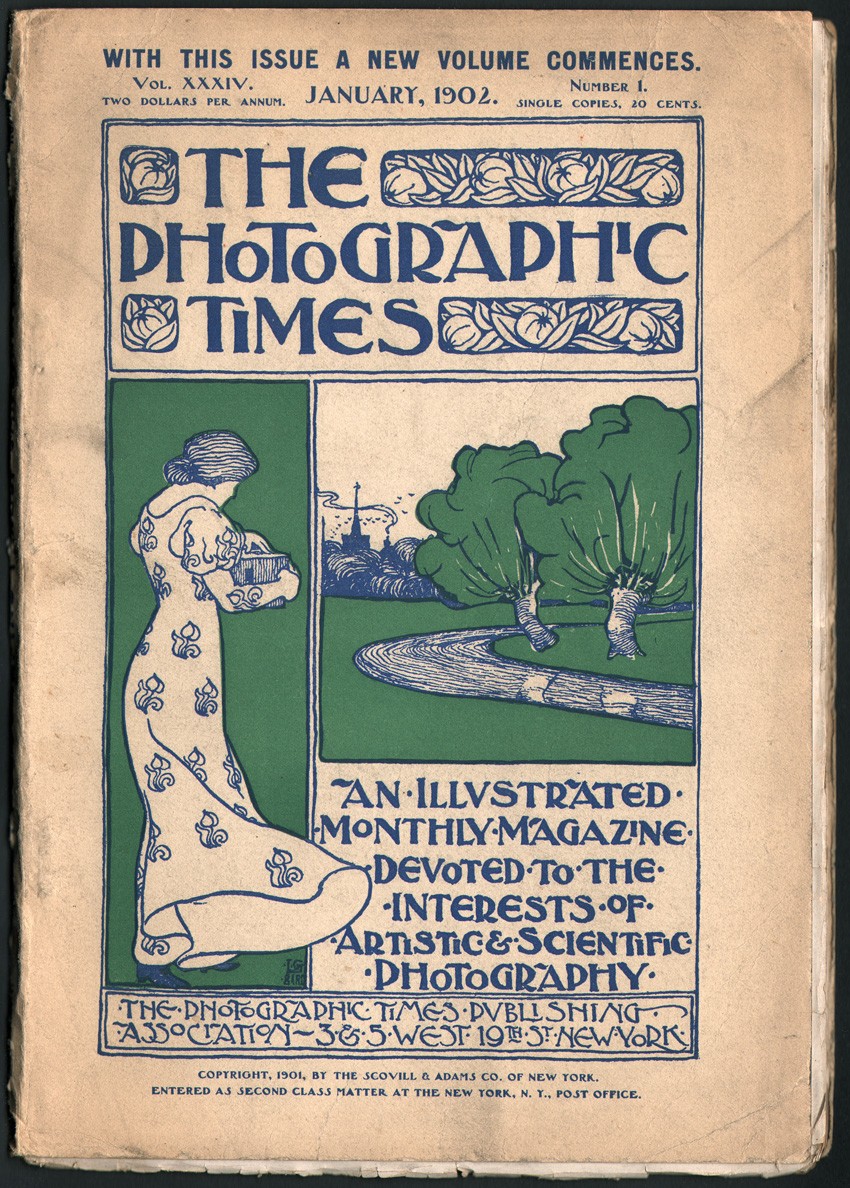 1902: A new cover design was introduced for The Photographic Times beginning with this issue in January, 1902. English artist Lennox G. Bird, who went by the professional moniker Curlew, (a playful association with his last name) had entered and won the Photographic Times silver medal competition the previous year. This design was used through at least January, 1903. Cover dimensions: 25.2 x 17.5 cm Cover: PhotoSeed Archive
1902: A new cover design was introduced for The Photographic Times beginning with this issue in January, 1902. English artist Lennox G. Bird, who went by the professional moniker Curlew, (a playful association with his last name) had entered and won the Photographic Times silver medal competition the previous year. This design was used through at least January, 1903. Cover dimensions: 25.2 x 17.5 cm Cover: PhotoSeed Archive
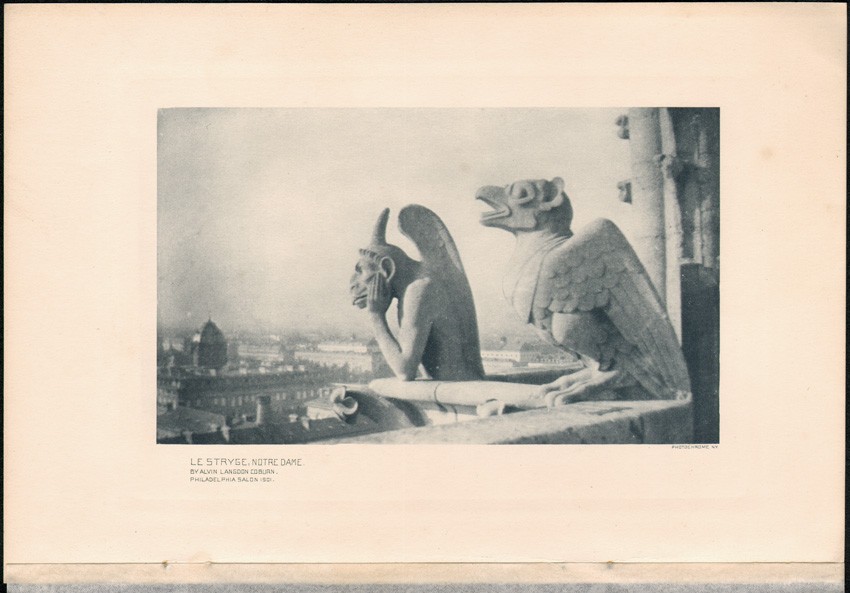 1902: Tissue-protected, hand-pulled photogravures like this example by American and later Welsh photographer Alvin Langdon Coburn (1882-1966) titled "Le Stryge; Notre Dame", continued to be featured in the Photographic Times, albeit in the smaller format beginning with the January, 1901 issue. Printed by the Photochrome Engraving Company of New York City, Coburn's photograph features two gargoyles watching over the city of Paris from a tower parapet of the Cathedral of Notre Dame. The image was inspired by French artist Charles Méryon's (1821-1868) 1853 etching of the gargoyle at center titled Le Stryge. (The Vampire) Plate dimensions: image: 10.0 x 16.4 cm | support:17.1 x 24.9 cm from: PhotoSeed Archive
1902: Tissue-protected, hand-pulled photogravures like this example by American and later Welsh photographer Alvin Langdon Coburn (1882-1966) titled "Le Stryge; Notre Dame", continued to be featured in the Photographic Times, albeit in the smaller format beginning with the January, 1901 issue. Printed by the Photochrome Engraving Company of New York City, Coburn's photograph features two gargoyles watching over the city of Paris from a tower parapet of the Cathedral of Notre Dame. The image was inspired by French artist Charles Méryon's (1821-1868) 1853 etching of the gargoyle at center titled Le Stryge. (The Vampire) Plate dimensions: image: 10.0 x 16.4 cm | support:17.1 x 24.9 cm from: PhotoSeed Archive
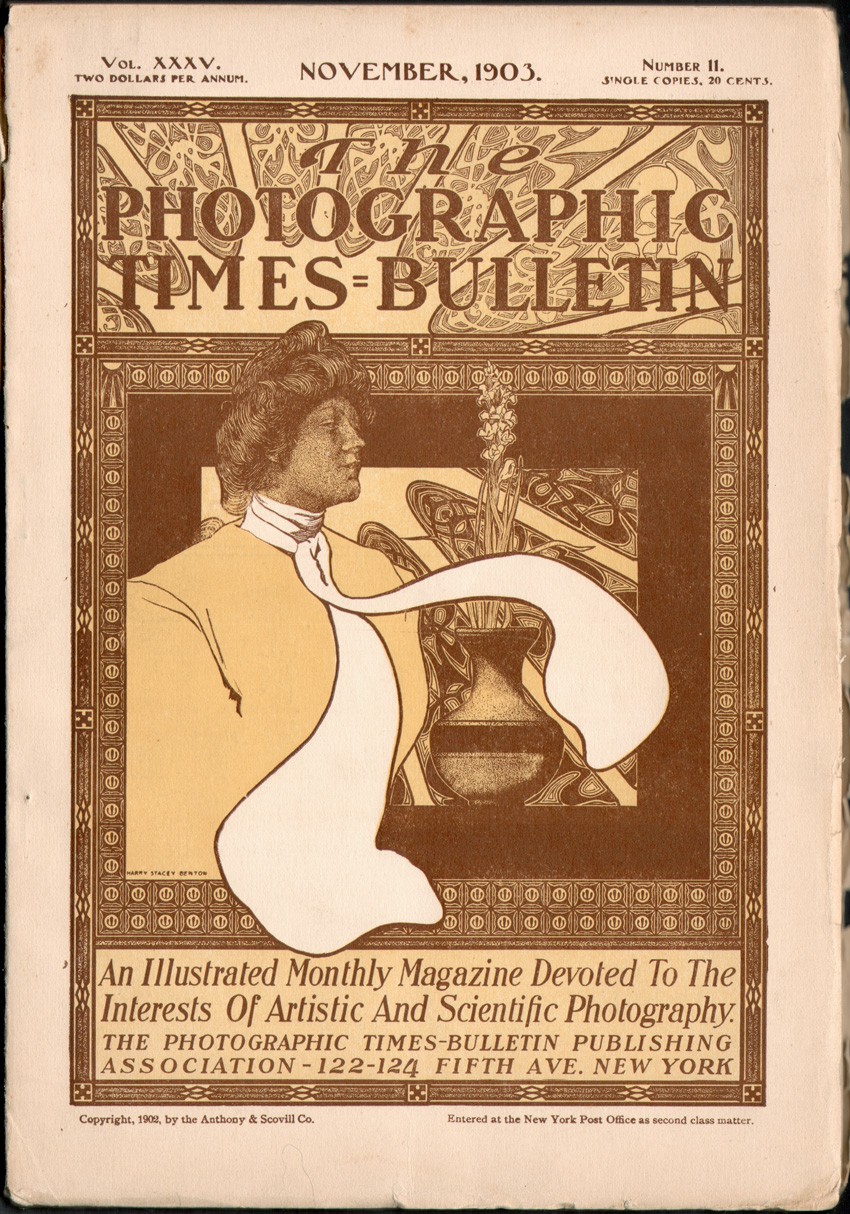 1902-1904: Beginning with the April, 1902 issue, the Photographic Times was renamed The Photographic Times-Bulletin, a combining of the Photographic Times and Anthony’s Photographic Bulletin, itself a result of the blockbuster December, 1901 business deal in which Scovill & Adams joined forces with the E. & H. T. Anthony & Company in order to fight off the mighty Kodak. Lennox G. Bird's cover design from 1902 carried over to the new publication until at least January, 1903, when this design by Chicago illustrator Harry Stacey Benton (b. 1876 or 1878) was used, most likely with the February issue. This was the final cover design for the Times-Bulletin which ceased publication under this name after the December, 1904 issue-reverting back to The Photographic Times in 1905. The wood-engraved, Art-Nouveau portrait of a woman with vase of flowers is set within an elaborate ornamental frame and printed in two colors. Cover dimensions: 25.2 x 17.5 cm. From: PhotoSeed Archive
1902-1904: Beginning with the April, 1902 issue, the Photographic Times was renamed The Photographic Times-Bulletin, a combining of the Photographic Times and Anthony’s Photographic Bulletin, itself a result of the blockbuster December, 1901 business deal in which Scovill & Adams joined forces with the E. & H. T. Anthony & Company in order to fight off the mighty Kodak. Lennox G. Bird's cover design from 1902 carried over to the new publication until at least January, 1903, when this design by Chicago illustrator Harry Stacey Benton (b. 1876 or 1878) was used, most likely with the February issue. This was the final cover design for the Times-Bulletin which ceased publication under this name after the December, 1904 issue-reverting back to The Photographic Times in 1905. The wood-engraved, Art-Nouveau portrait of a woman with vase of flowers is set within an elaborate ornamental frame and printed in two colors. Cover dimensions: 25.2 x 17.5 cm. From: PhotoSeed Archive
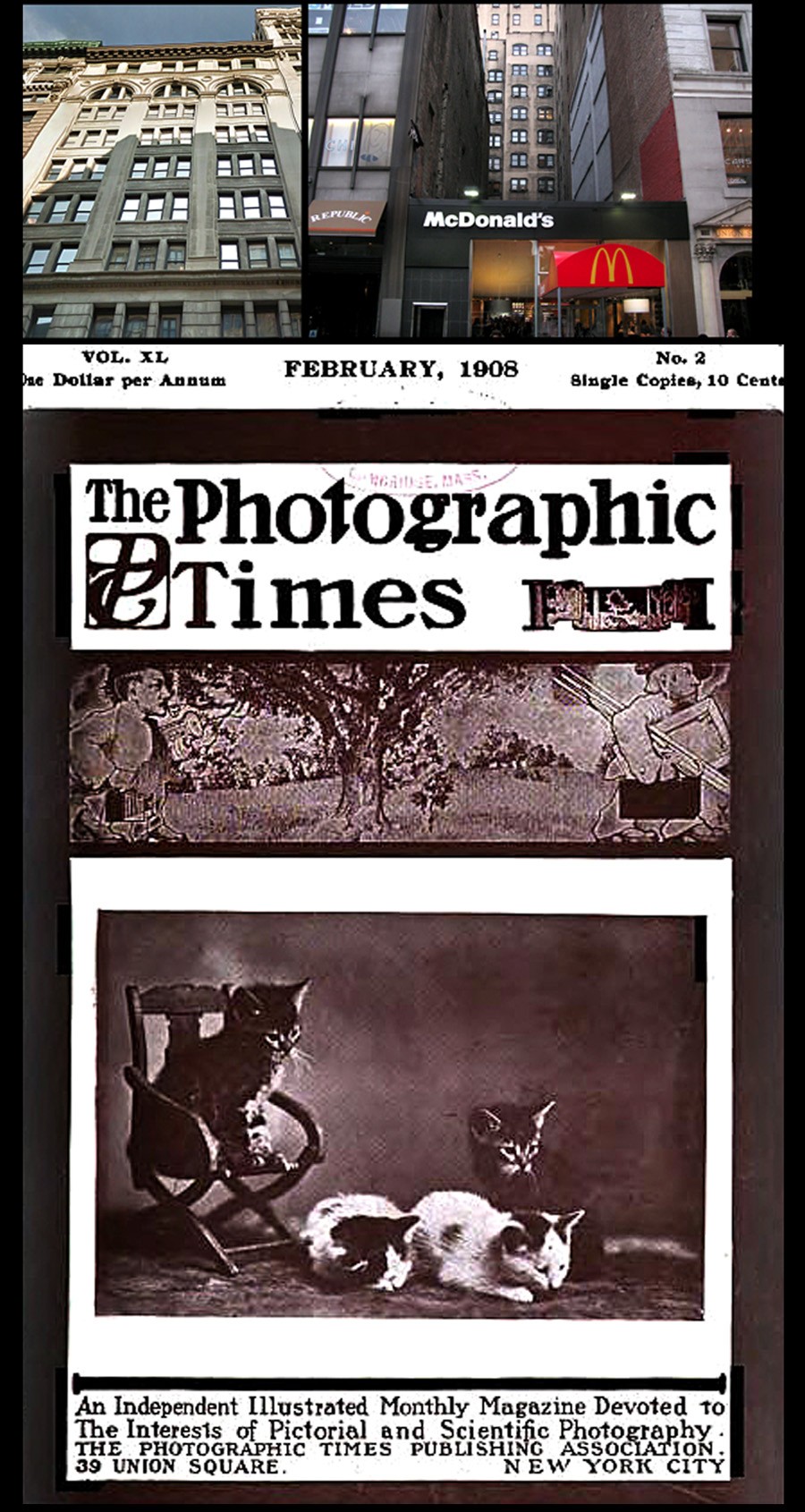 1902-1903 | 1904 | 1904-1908: Three address and two ownership changes took place for the Times-Bulletin and Photographic Times between 1902-1908. Upper left photo: from 1902-1903, the Times-Bulletin was published from this ornate building at 122-124 Fifth Ave.; the home of the combined firm of the Anthony & Scovill Company. By April of 1904, Lincoln Adams had bought out Anthony & Scovill's controlling interest in the journal, retaining the journal's name through the end of the year and moving the offices to Styles & Cash Printers at 75-77 Eighth Ave., a company he was president of. (this building no longer stands and is now occupied by an ornate bank building now turned into luxury condos) Upper right photo: from December, 1904 through 1908, the renamed Photographic Times (January, 1905) was published in a building that also no longer stands at 39 Union Square West, now the location of a McDonald's restaurant. Bottom cover: This is a representative cover of the Times from the Union Square years. Now priced at 10 cents, or a dollar a year, it featured a whimsical caricature of a photographer with camera in hand following an artist who holds his canvas and easel in pursuit of the next great vista anchored below the journal masthead. The February, 1908 cover art featured a large halftone photograph of decidedly "light" subject matter: a grouping of kittens. Reflecting this decidedly saccharine mass-market appeal, the Times guiding principal at bottom of cover also had changed to: "An Independent Illustrated Monthly Magazine Devoted to The Interests of Pictorial and Scientific Photography." Photo credits: Anthony & Scovill: Google Street View; Union Square: David Spencer/PhotoSeed Archive, cover: HathiTrust
1902-1903 | 1904 | 1904-1908: Three address and two ownership changes took place for the Times-Bulletin and Photographic Times between 1902-1908. Upper left photo: from 1902-1903, the Times-Bulletin was published from this ornate building at 122-124 Fifth Ave.; the home of the combined firm of the Anthony & Scovill Company. By April of 1904, Lincoln Adams had bought out Anthony & Scovill's controlling interest in the journal, retaining the journal's name through the end of the year and moving the offices to Styles & Cash Printers at 75-77 Eighth Ave., a company he was president of. (this building no longer stands and is now occupied by an ornate bank building now turned into luxury condos) Upper right photo: from December, 1904 through 1908, the renamed Photographic Times (January, 1905) was published in a building that also no longer stands at 39 Union Square West, now the location of a McDonald's restaurant. Bottom cover: This is a representative cover of the Times from the Union Square years. Now priced at 10 cents, or a dollar a year, it featured a whimsical caricature of a photographer with camera in hand following an artist who holds his canvas and easel in pursuit of the next great vista anchored below the journal masthead. The February, 1908 cover art featured a large halftone photograph of decidedly "light" subject matter: a grouping of kittens. Reflecting this decidedly saccharine mass-market appeal, the Times guiding principal at bottom of cover also had changed to: "An Independent Illustrated Monthly Magazine Devoted to The Interests of Pictorial and Scientific Photography." Photo credits: Anthony & Scovill: Google Street View; Union Square: David Spencer/PhotoSeed Archive, cover: HathiTrust
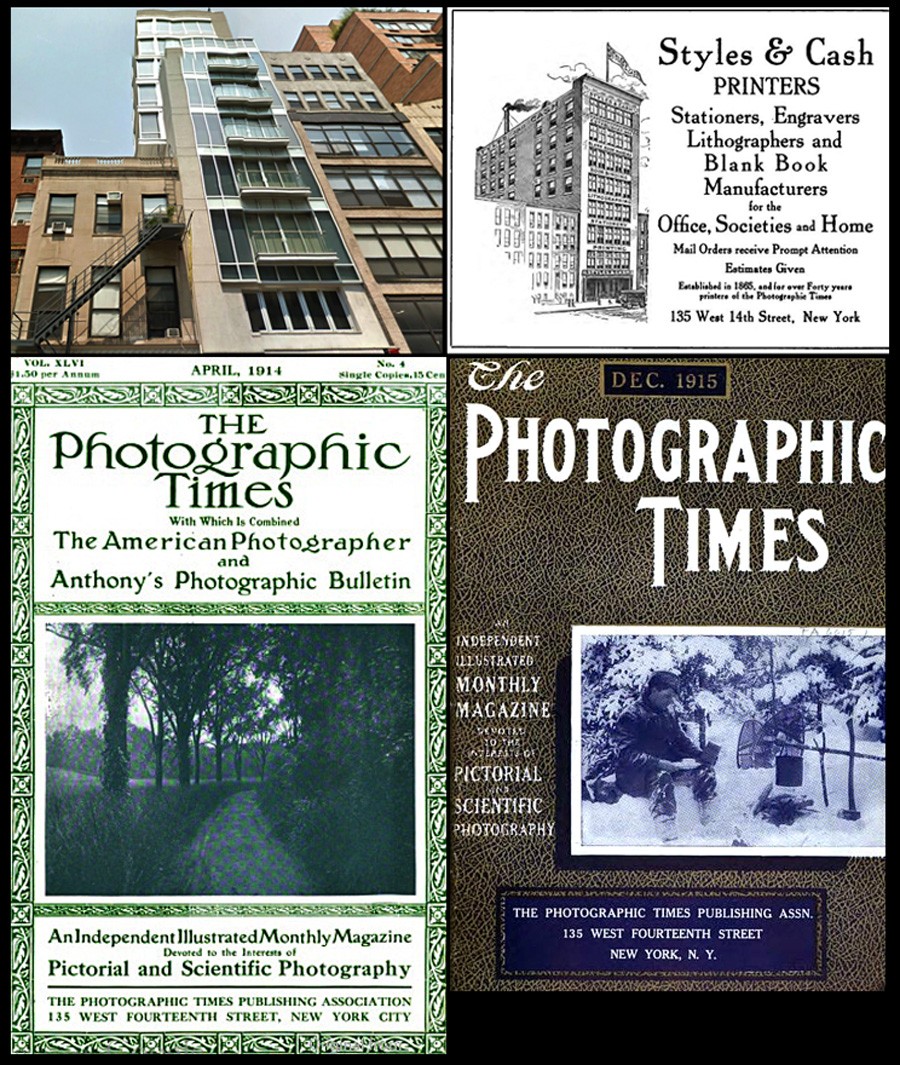 1909-1915: Under The Photographic Times Publishing Association, the Times was edited and published the final six years from this building at 135 West 14th street at top left: a ten-story building erected in 1906 by architect Charles Birge for the printing firm Styles & Cash. Since remade (2004) into condos on the upper floors with a hair salon at street level, a December, 1915 advertisement in the Times for the company is at top right. Two other cover design changes for the journal took place during this period. At lower left is the issue from April, 1914 and at lower right, the final cover for the December, 1915 issue. The Styles & Cash firm was in operation in New York from 1865-1920. Photo credits: Styles & Cash: Google Street View; ad & covers: HathiTrust
1909-1915: Under The Photographic Times Publishing Association, the Times was edited and published the final six years from this building at 135 West 14th street at top left: a ten-story building erected in 1906 by architect Charles Birge for the printing firm Styles & Cash. Since remade (2004) into condos on the upper floors with a hair salon at street level, a December, 1915 advertisement in the Times for the company is at top right. Two other cover design changes for the journal took place during this period. At lower left is the issue from April, 1914 and at lower right, the final cover for the December, 1915 issue. The Styles & Cash firm was in operation in New York from 1865-1920. Photo credits: Styles & Cash: Google Street View; ad & covers: HathiTrust
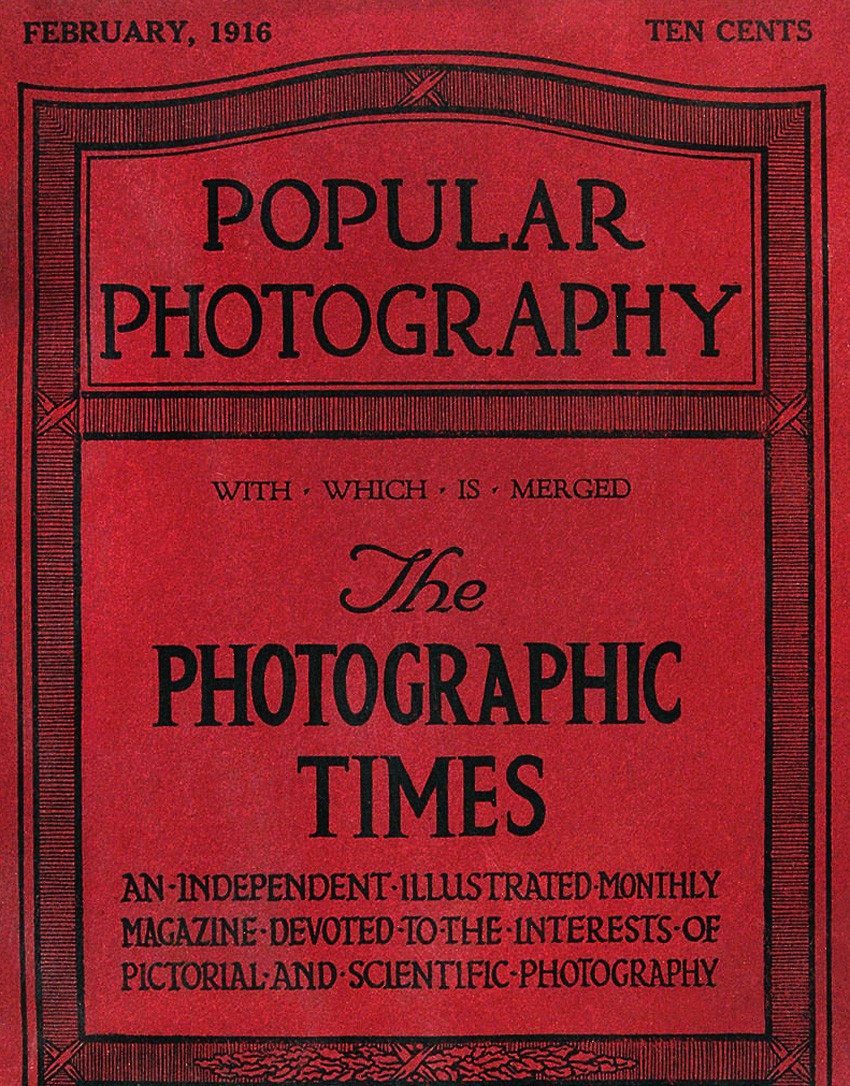 1916: With Which Is Merged: Beginning with the January, 1916 issue, the Times masthead was gone for good: absorbed into Popular Photography, a new journal published in Boston since October, 1912. Edited by Frank Roy Fraprie, W. I. Lincoln Adams was retained as an associate editor, although it is doubtful he had much of a hand with its affairs. Cover detail: February, 1916: Ebay
1916: With Which Is Merged: Beginning with the January, 1916 issue, the Times masthead was gone for good: absorbed into Popular Photography, a new journal published in Boston since October, 1912. Edited by Frank Roy Fraprie, W. I. Lincoln Adams was retained as an associate editor, although it is doubtful he had much of a hand with its affairs. Cover detail: February, 1916: Ebay
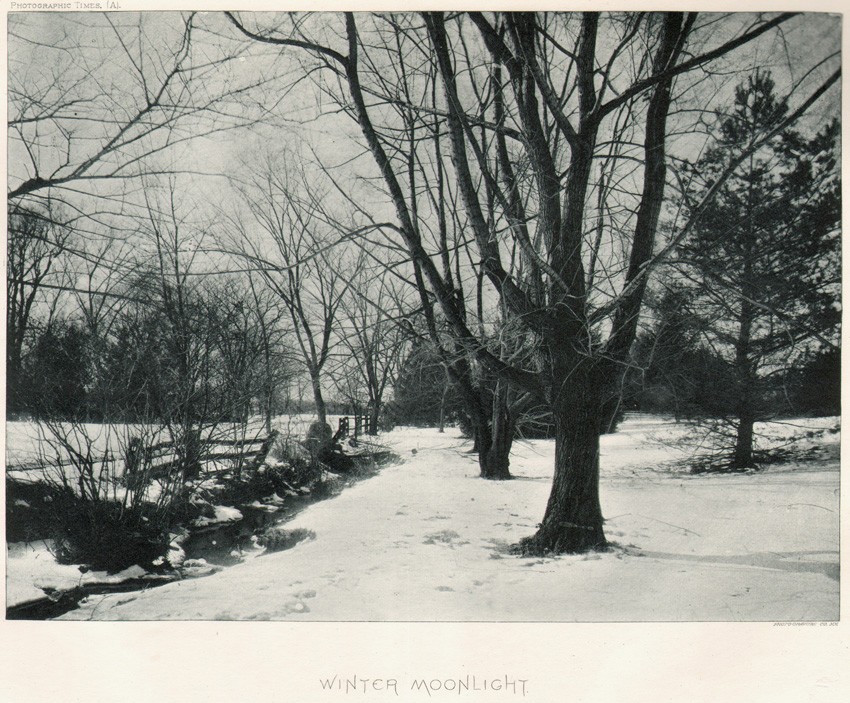 The Photographic Times was a labor of love for a father and son. Washington Irving Adams had the spark and drive to get the journal up and running beginning in 1870 and son W. I. Lincoln Adams dutifully took over the reigns of not only the journal but the Scovill & Adams firm upon his father's passing. In my view, the legacy they left in the form of the journal is invaluable, with their efforts along with many others giving enjoyment and continuing instruction on the art and science of photography from 1871-1915 we should continue to appreciate and investigate. This landscape study "Winter Moonlight" by Lincoln Adams was taken around 1885 and published in the Times in 1890. It is not especially memorable in my view, but does contain the kernel of adventure all photography has: "Let the landscape loving photographer of this city and neighborhood take a ramble with his camera" the Times copywriter (possibly Adams himself) declared as inspiration taken from the scene of this snow-blanketed wooded glade. Continuing the thought, "Mr. Adams is always eager to conduct a party, large or small, to the beautiful haunts about his picturesque home." As a young photographer myself, this was just the type of place I took my own camera to in search of what photography could accomplish and mean while learning most about my own self. My hunch is Adams own tramps in places like this shaped his thinking and outlook as well. Image: 14.4 x 19.7 cm | support: 20.5 x 28.7 cm. : photogravure in The Photographic Times, February 7, 1890 | issue No. 438: From: PhotoSeed Archive
The Photographic Times was a labor of love for a father and son. Washington Irving Adams had the spark and drive to get the journal up and running beginning in 1870 and son W. I. Lincoln Adams dutifully took over the reigns of not only the journal but the Scovill & Adams firm upon his father's passing. In my view, the legacy they left in the form of the journal is invaluable, with their efforts along with many others giving enjoyment and continuing instruction on the art and science of photography from 1871-1915 we should continue to appreciate and investigate. This landscape study "Winter Moonlight" by Lincoln Adams was taken around 1885 and published in the Times in 1890. It is not especially memorable in my view, but does contain the kernel of adventure all photography has: "Let the landscape loving photographer of this city and neighborhood take a ramble with his camera" the Times copywriter (possibly Adams himself) declared as inspiration taken from the scene of this snow-blanketed wooded glade. Continuing the thought, "Mr. Adams is always eager to conduct a party, large or small, to the beautiful haunts about his picturesque home." As a young photographer myself, this was just the type of place I took my own camera to in search of what photography could accomplish and mean while learning most about my own self. My hunch is Adams own tramps in places like this shaped his thinking and outlook as well. Image: 14.4 x 19.7 cm | support: 20.5 x 28.7 cm. : photogravure in The Photographic Times, February 7, 1890 | issue No. 438: From: PhotoSeed Archive
Heels of Progress
Posted May 2012 in History of Photography, Scientific Photography
If you ever wanted to learn about the importance assigned or excitement surrounding the discovery of the X-Ray, look no further than any photographic journal published the world over between 1896-1897. Chronicled in breathless detail within their many pages, this new and miraculous revelation was aided by photography’s very ability to record the see-through results of these “mysterious rays” on a myriad of materials.
 "Foot in a Shoe": full-page halftone plate identified as figure 6 accompanying article "Radiography and its Application" published in "The Photographic Times": July: 1896. Believed to be photographed by author Arthur Willis Goodspeed with the assistance of G. C. McKee.
"Foot in a Shoe": full-page halftone plate identified as figure 6 accompanying article "Radiography and its Application" published in "The Photographic Times": July: 1896. Believed to be photographed by author Arthur Willis Goodspeed with the assistance of G. C. McKee.
And so this new victory was shouted far and wide: the symbolic Iron Heel of Progress, represented by the dual disciplines of scientific investigation and photography coming together, marched forward. In my own convoluted way of thinking, the splendid specimen of shoe including said iron-studded heel protecting a foot within makes perfect sense, literally and perhaps symbolically making a full-page debut along with other objects in the July, 1896 issue of The Photographic Times.
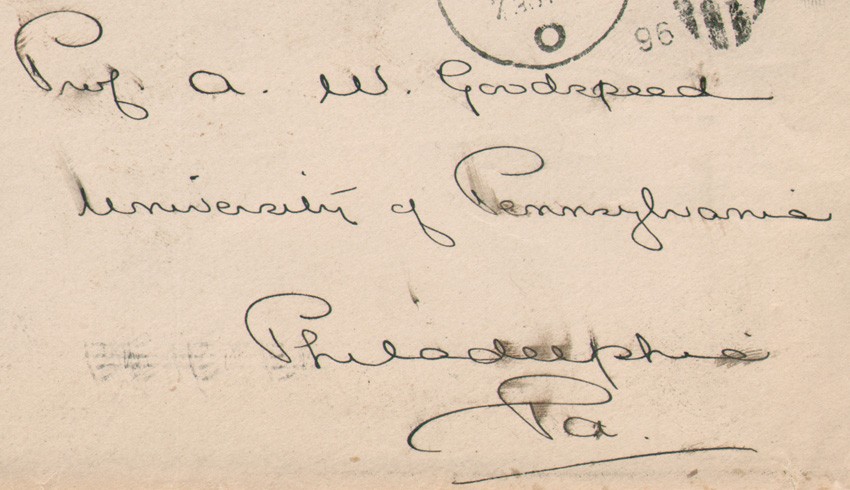 University of Pennsylvania physics professor and Radiology pioneer Arthur Willis Goodspeed was the addressee of this personal letter sent by Photographic Times editor Walter E. Woodbury in 1896 seeking the procurement of X-Ray photographs to accompany Goodspeed's published July issue article: "Radiography and its Application". Detail from original envelope with dimensions of 9.3 x 16.5 cm
University of Pennsylvania physics professor and Radiology pioneer Arthur Willis Goodspeed was the addressee of this personal letter sent by Photographic Times editor Walter E. Woodbury in 1896 seeking the procurement of X-Ray photographs to accompany Goodspeed's published July issue article: "Radiography and its Application". Detail from original envelope with dimensions of 9.3 x 16.5 cm
The reason for all this excitement was the official announcement late the year before: German physicist Wilhelm Röntgen (1845-1923) had “produced and detected electromagnetic radiation in a wavelength range today known as X-rays or Röntgen rays”. (1.) For his efforts, Röntgen in 1901 was awarded the first Nobel Prize in Physics.
I will be the first to admit scientific photography is not a collecting focus for the PhotoSeed archive, however, the possession of a postal cover and several pages from a hand-written letter by Photographic Times editor Walter E. Woodbury (1865-1905) posted to this site was reason enough to visually explore X-Ray photography in this space as the profound discovery it remains even today. On May 22nd, while working in advance of the July issue, Woodbury penned a short missive to America’s equivalent of Röntgen: University of Pennsylvania physics professor Arthur Willis Goodspeed. (1860-1943) Radiography and its Application was the name of the article he had already written, dated April 30th and eventually published. But at the time, working more than a month in advance, editor Woodbury was willing to hold up publication of his journal until he could secure the necessary photographs showing the dry-plate, x-ray-effected negatives he knew would cause a stir, and thus providing proof for and generating interest in Goodspeed’s article.
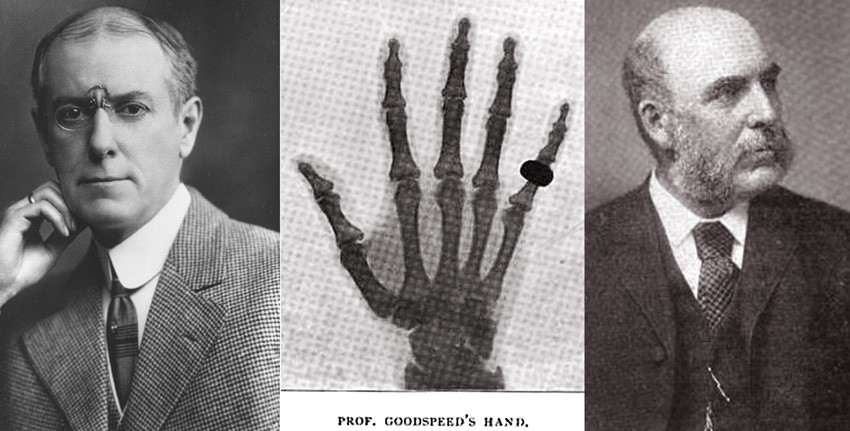 Left: Arthur Willis Goodspeed (1860-1943) circa 1903-04 when he was 4th President of the American Roentgen Ray Society. Middle: An X-Ray photographic negative from 1896 showing Goodspeed's hand taken by Philadelphia photographer John Carbutt. Right: Englishman John Carbutt, (1832-1905) inventor of specialized glass dry plates sensitive to the newly identified x-rays that were provided to Goodspeed for research purposes.
Left: Arthur Willis Goodspeed (1860-1943) circa 1903-04 when he was 4th President of the American Roentgen Ray Society. Middle: An X-Ray photographic negative from 1896 showing Goodspeed's hand taken by Philadelphia photographer John Carbutt. Right: Englishman John Carbutt, (1832-1905) inventor of specialized glass dry plates sensitive to the newly identified x-rays that were provided to Goodspeed for research purposes.
Goodspeed was no stranger to photographic experimentation. In the mid 1880’s he had witnessed and assisted the English photographer Eadweard Muybridge (1830-1904) while he conducted the now famous Animal Locomotion studies under the support of the University of Pennsylvania and more unbelievably, had made by accident along with British photographer William Jennings, the first known X-Ray photograph in the physical lecture room at the school on February 22, 1890 . A centennial remembrance written by TL Walden Jr. for the journal Radiology in 1991 partly states:
On that evening, Goodspeed and Jennings had been making brush electrographs of coins and brass weights. After they finished their experiments, Jennings stacked all of the photographic plates; two coins—either left from the experiments or Jennings’ trolley fare—were placed on top of the plates. Goodspeed then demonstrated to Jennings the university’s collection of Crookes tubes, with the idea of photographing the glow from the tube. While the two men were talking, however, the Crookes tube was emitting x radiation that affected the nearby plates. After the plates were developed, Jennings noted that one had the shadow(s) of a disk(s) on it; neither man could explain the image. (2.)
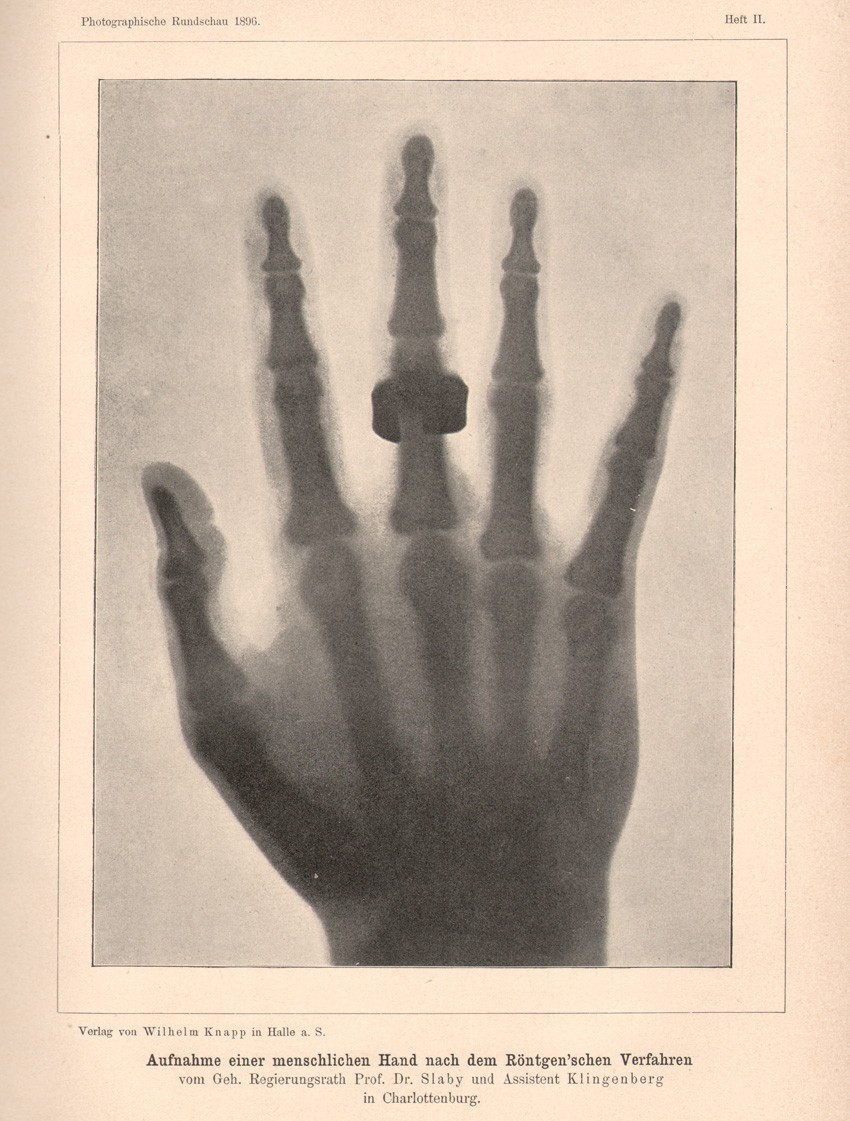 One of the most popular subjects it seems for early depictions of X-Ray negative photographs was the human hand. This full-page halftone presentation of a full hand with ring was included in the February, 1896 issue of the German photographic journal Photographische Rundschau. Original caption: Aufnahme einer menschlichen Hand nach dem Röntgen'schen Verfahren vom Geh. Regierungsrath Prof. Dr. Slaby und Assistent Klingenberg in Charlottenburg.
One of the most popular subjects it seems for early depictions of X-Ray negative photographs was the human hand. This full-page halftone presentation of a full hand with ring was included in the February, 1896 issue of the German photographic journal Photographische Rundschau. Original caption: Aufnahme einer menschlichen Hand nach dem Röntgen'schen Verfahren vom Geh. Regierungsrath Prof. Dr. Slaby und Assistent Klingenberg in Charlottenburg.
The photographic holdup for Woodbury was worth it. Englishman John Carbutt, (1832-1905) who had first made a name for himself in America by taking stereoscopic landscape photographs as well as running a Chicago portrait studio in the 1860’s, had become an important collaborator in the late 1890’s with Goodspeed in Philadelphia. Carbutt’s invention of specialized glass dry plates sensitive to the newly identified x-rays were provided to Goodspeed for research purposes; the same year his article appeared in The Photographic Times. Carbutt’s role as well as the importance of these plates was acknowledged in it:
With a view to developing the sensitive plate to produce the best results possible, Mr. John Carbutt has given untiring attention and made many experiments. The Carbutt plates have most of them been tested by the writer in comparison with other makes, and those now in use give by far the best results of any yet tried. The negatives from which the illustrations accompanying this article have been reproduced are samples of the plates referred to. (3.)
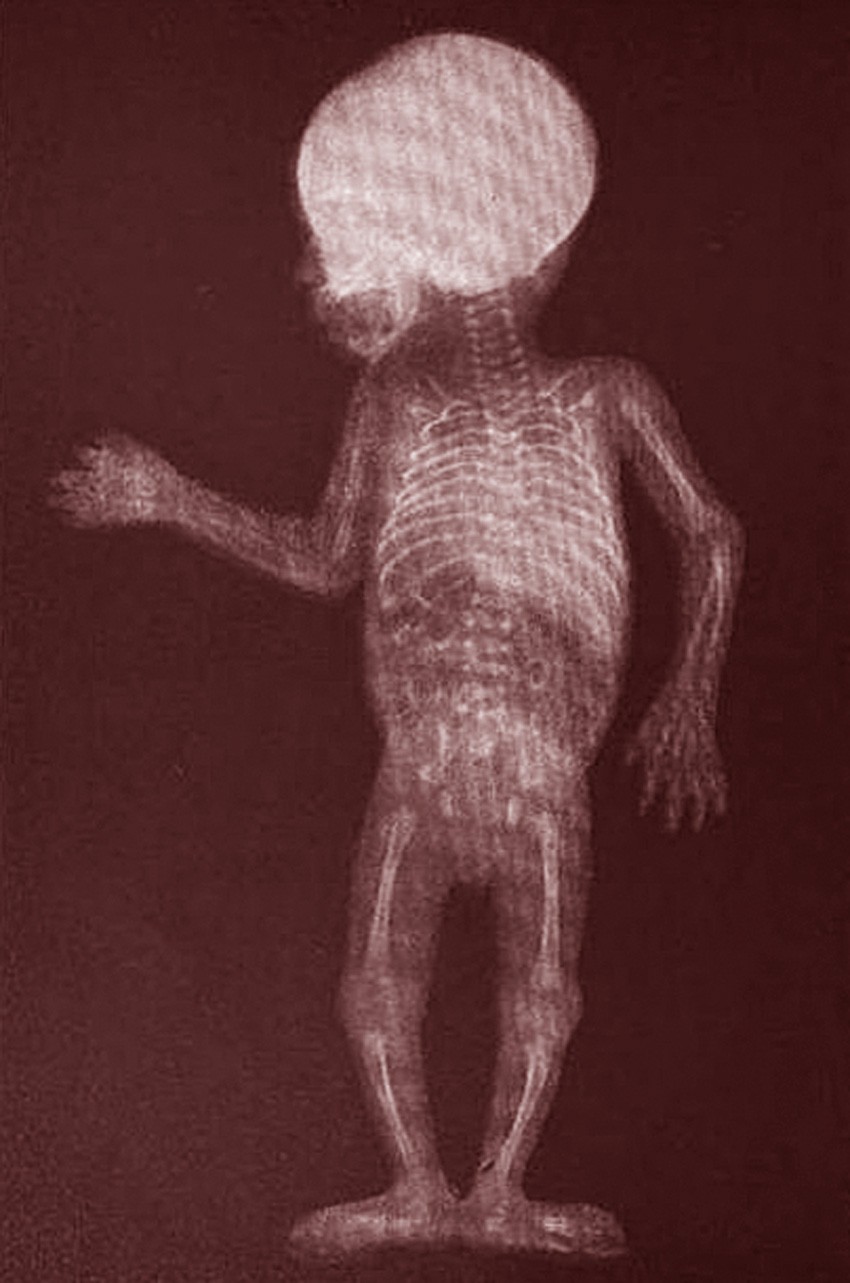 Unknown health hazards did not seem to present issues with photographers keen to exploit the miracle that was X-Ray photography when first discovered in late 1895. Although it is not known what the exposure time for this 3 day old child was when Philadelphia photographer John Carbutt recorded it in 1896, exposures of over 1 hour in length are commonly mentioned. This photograph appeared as a full-page halftone in the December, 1896 issue of "The American Amateur Photographer".
Unknown health hazards did not seem to present issues with photographers keen to exploit the miracle that was X-Ray photography when first discovered in late 1895. Although it is not known what the exposure time for this 3 day old child was when Philadelphia photographer John Carbutt recorded it in 1896, exposures of over 1 hour in length are commonly mentioned. This photograph appeared as a full-page halftone in the December, 1896 issue of "The American Amateur Photographer".
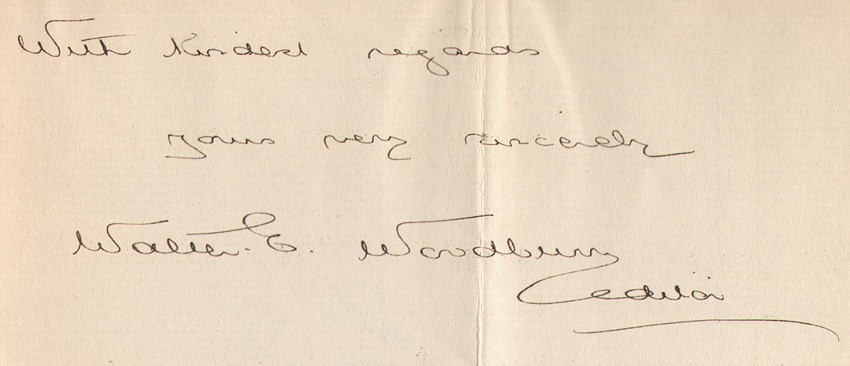 "Photographic Times" editor Walter Edward Woodbury (1865-1905) was the son of Walter B. Woodbury, who invented the Woodburytype. Woodbury edited the journal from 1895-1899. He died from yellow fever while later editing the English section of the "Panama Star and Herald and Inter-Ocean Critic" newspaper in Panama.
"Photographic Times" editor Walter Edward Woodbury (1865-1905) was the son of Walter B. Woodbury, who invented the Woodburytype. Woodbury edited the journal from 1895-1899. He died from yellow fever while later editing the English section of the "Panama Star and Herald and Inter-Ocean Critic" newspaper in Panama.
In closing, and with a nod to collectors like myself seeking out the ultimate published examples of Röntgen, or X-Ray scientific photographs, I suggest a further investigation of the 15 oversized, hand-pulled photogravure plates published in 1896 under the direction of Austrian photo-chemists Josef Maria Eder and Eduard Valenta. Containing magnificent studies of human bones, various small animals as well as man-made objects including a set of lockets, this portfolio, titled Versuche über Photographie mittelst der Röntgen’schen Strahlen, features as its’ final plate the now iconic coiled snake titled Aesculap-Schlange. First taken by Eder and Valenta and presented to members of the Viennese Photographic Society in January of 1896, (4.) these photographs have long ago entered the canon of modern photographic art, a scant two months after Röntgen’s initial discovery shook the world.
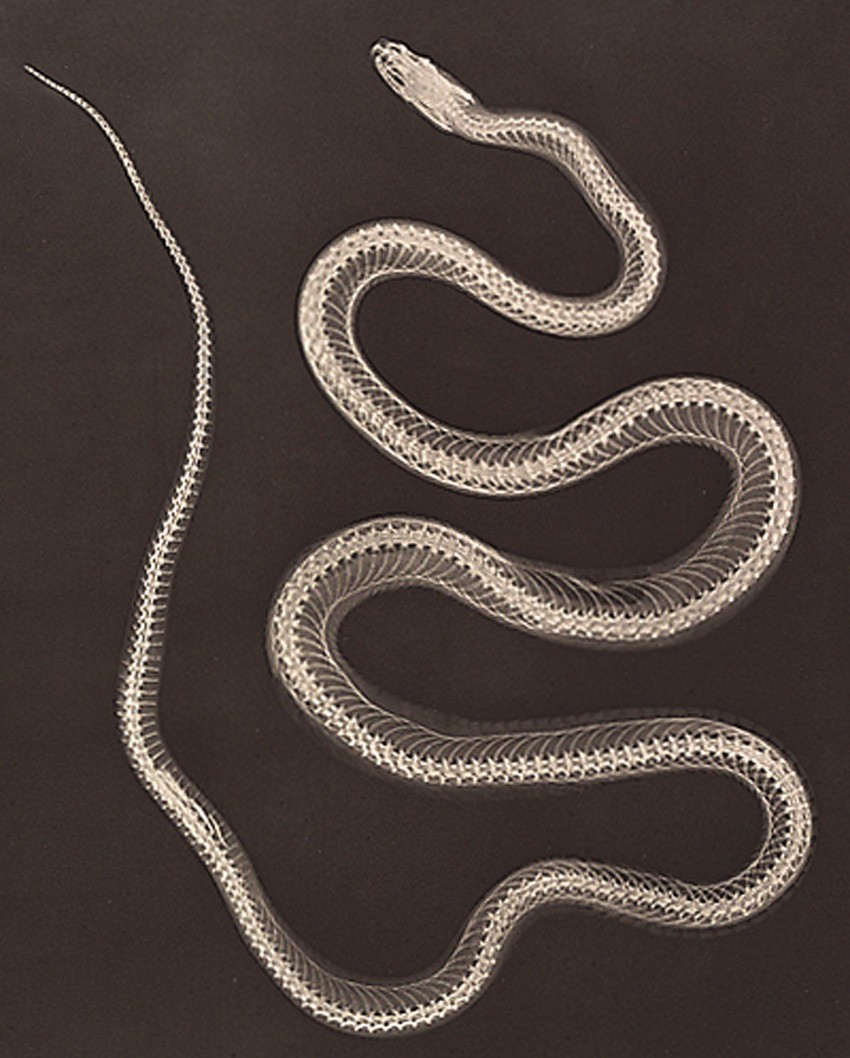 Detail: Aesculap-Schlange (Facsimile des Negativs). pl. XV: from portfolio: "Versuche über Photographie mittelst der Röntgen'schen Strahlen" published in 1896 as a large plate photogravure. Symbolic of healing and native to Europe, the Aesculapian snake is associated with the Greek god Asclepius and Roman god Aesculapius. The symbol of modern human medicine is often represented by this snake intertwined around a rod.
Detail: Aesculap-Schlange (Facsimile des Negativs). pl. XV: from portfolio: "Versuche über Photographie mittelst der Röntgen'schen Strahlen" published in 1896 as a large plate photogravure. Symbolic of healing and native to Europe, the Aesculapian snake is associated with the Greek god Asclepius and Roman god Aesculapius. The symbol of modern human medicine is often represented by this snake intertwined around a rod.
1. Wilhelm Röntgen: from: Wikipedia: accessed: 2012
2. excerpt: The first radiation accident in America: a centennial account of the x-ray photograph made in 1890: TL Walden Jr.:in: Radiology: December, 1991: pp. 635-639
3. excerpt: Radiography and its Application: A.W. Goodspeed: in: The Photographic Times: New York: July, 1896: pp. 308-309
4. from: Beauty of Another Order-Photography in Science: Ann Thomas: Yale University Press: New Haven and London, in association with the National Gallery of Canada, Ottawa; 1997
Kodak's Work not Done
Posted January 2012 in History of Photography
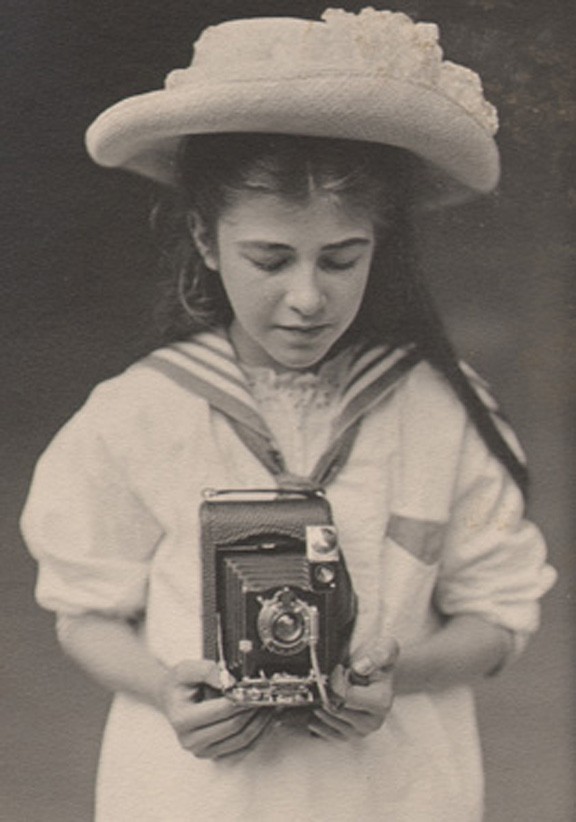 Detail: "Girl with Kodak": particulars witheld: vintage platinum print from PhotoSeed archive: circa 1907-08: 22.9 x 13.2 cm (mount: 33.5 x 23.6 cm)
Detail: "Girl with Kodak": particulars witheld: vintage platinum print from PhotoSeed archive: circa 1907-08: 22.9 x 13.2 cm (mount: 33.5 x 23.6 cm)The inevitable yet sad news today of the Eastman Kodak Company’s filing for bankruptcy protection in the court of the Southern District of New York state did not come as a surprise to those of us who have been paying attention to the company’s mounting woes over the past several decades. However, what is more shocking to me is how the once ubiquitous Kodak brand no longer figures in any cultural discourse as it pertains to amateur photography considering its formerly ubiquitous place in that very culture.
Alfred Stieglitz might have used up part of his 15 minutes of fame, to quote another artist provocateur, by railing against the culture of a company that promised to do the rest after you pressed their many shutter buttons, but even he could certainly not deny the value and cumulative effect all those hundreds of millions, perhaps billions, of little yellow boxes containing treasures not yet exposed had when opened by the masses. The bicycle craze be damned you say? Without naming names, I know for a fact more than a few caught opening up one of those many Kodak boxes on a weekend trip to the country or simply photographing the amorphous shapes of pots and pans in their own sink using Kodak film who went on to became famous or infamous photographers in their own right. Their efforts have contributed much to the history of Photography and even changed-and continue to do so- the perception of visual ideas by way of a camera lens-using a Kodak or some other brand.
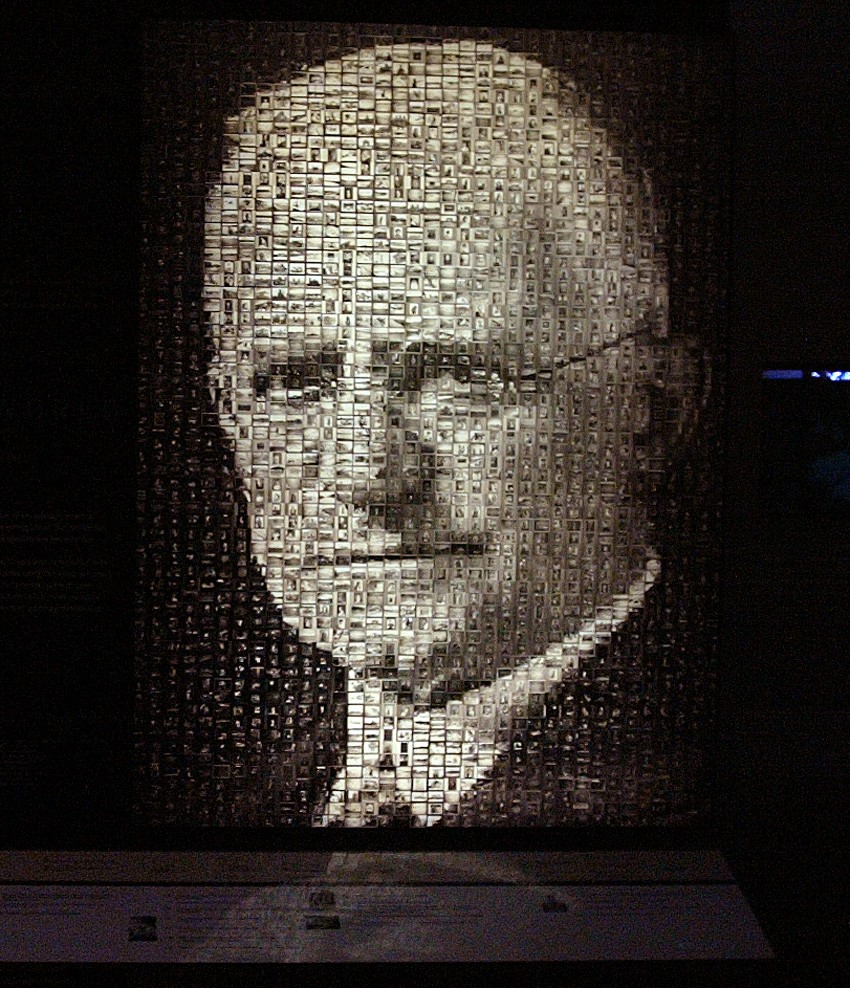 Audiovisual display of George Eastman: a composite portrait done with hundreds of individual photographs held in the George Eastman House International Museum of Photography and Film collections. Rochester: George Eastman House public exhibit space: Photograph by David Spencer: 2004
Audiovisual display of George Eastman: a composite portrait done with hundreds of individual photographs held in the George Eastman House International Museum of Photography and Film collections. Rochester: George Eastman House public exhibit space: Photograph by David Spencer: 2004And if you will pardon my own rant for only a moment, a little historical background please, if only to diffuse some of the screeds I’ve been reading lately upon said company’s demise-for it is still a remarkable achievement- and rare-that an enterprise such as Kodak has been able to survive for 131 years, even in bankruptcy reorganization.
The founder, George Eastman, (1854-1932) surely had his faults. If you care to read, as I have been, Elizabeth Brayer’s important and exhaustive biography of Eastman first published in 1996, you will find however that they were abundantly balanced with a philanthropy not exercised enough in modern times. You will learn Eastman was anti-union and ran a company whose tentacles reached around the world to defend Kodak patents to the point of stifling innovation. And if that didn’t work out, he would just offer up a mountain of cash in order to buy out the other guy in route to creating and maintaining a monopoly of those yellow boxes as well as the manufacturer of the very cameras using the gelatinous rolled film found inside of them.
 Detail: official court transcript document of Eastman Kodak Company Chapter 11 Bankruptcy filing: Southern District of New York state: Manhatten, New York: January 19, 2012.
Detail: official court transcript document of Eastman Kodak Company Chapter 11 Bankruptcy filing: Southern District of New York state: Manhatten, New York: January 19, 2012.Eastman, a man of the gilded age who harnessed the sweat of America’s Industrial Revolution for fantastic riches, also gave back-enough so in my opinion to become basis as unwitting poster child to the very idea behind the formation of an American middle class. As chronicled in Brayer’s volume, Eastman in the guise of the anonymous “Mr. Smith”, gave upwards of 20 million dollars in his lifetime-almost single handedly building the fledgling Massachusetts Institute of Technology (MIT) from the ground up. But he also donated millions more to the children and citizens of his very own Rochester in the form of brand new dental clinics. How do scores, let alone successive generations, put a long-term value on both brains and good teeth?
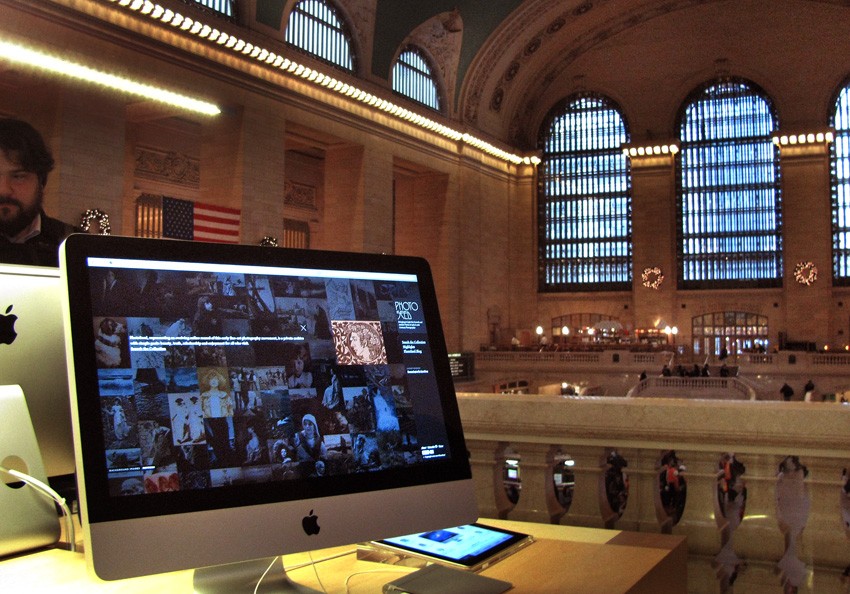 Kodak's famous Colorama displays were formerly projected from the area now currently occupied by Apple's newest store in Grand Central Terminal in New York City. With my sincerest apologies, I'll shamelessly use this opportunity as a plug for yours truly. Photograph by David Spencer: 2011
Kodak's famous Colorama displays were formerly projected from the area now currently occupied by Apple's newest store in Grand Central Terminal in New York City. With my sincerest apologies, I'll shamelessly use this opportunity as a plug for yours truly. Photograph by David Spencer: 2011For myself, Kodak was most definitely alive and bigger than life as I walked into Manhattan’s Grand Central Terminal as a kid in the late 1960’s and marveled at their magnificent Colorama displays. For those indelible images, courtesy of Kodak and a healthy dose of Life magazine, I’ll say thanks and count myself a photographer forever. In regards to my recent trek through Grand Central, the ubiquity of another brand-Apple, now holds court where those giant transparencies formerly shown bright. Genius Bar indeed.
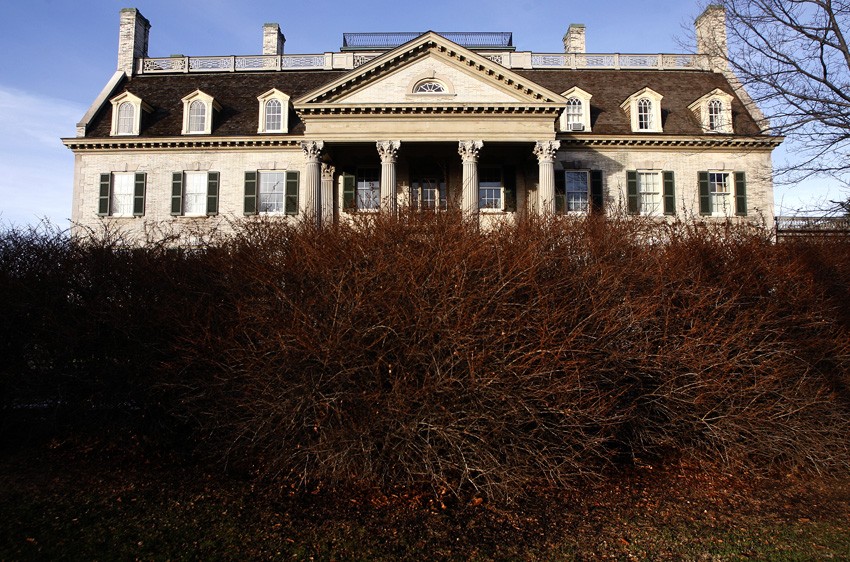 Mansion facade: The George Eastman House International Museum of Photography and Film-a different look I hope….Rochester, New York: 2009. Photograph by David Spencer
Mansion facade: The George Eastman House International Museum of Photography and Film-a different look I hope….Rochester, New York: 2009. Photograph by David SpencerIn light of this recent bankruptcy news and its effect on those separate but linked entities of the Kodak company itself- the city of Rochester as well as the guardian, research institution and public display facility extraordinaire to the history of Photography- the George Eastman House International Museum of Photography and Film- my message is, please carry on. And to all those affiliated or working in both places, let me apologize for Mr. Eastman just this once and say chin up, your work is most definitely not done, and hopefully never will be.
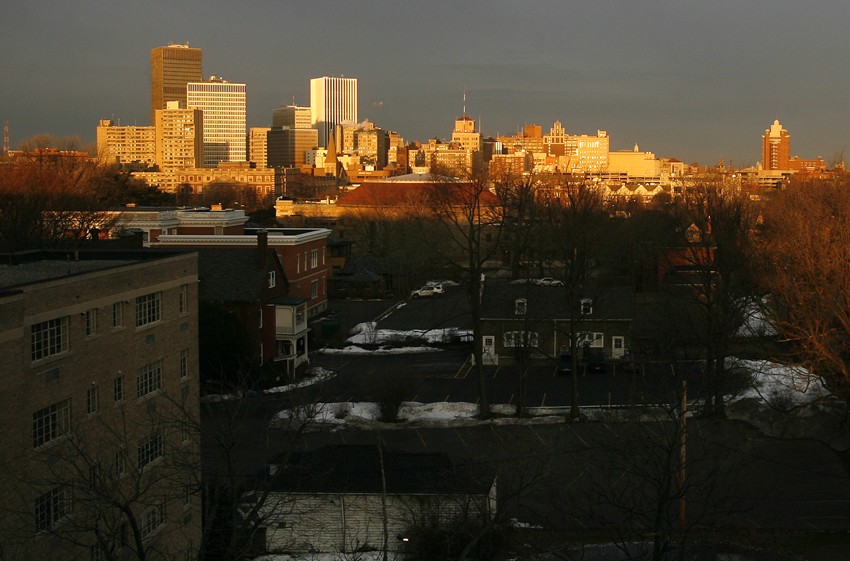 Sunrise over the city of Rochester, New York: February, 2009. A new beginning for sure. Photograph by David Spencer
Sunrise over the city of Rochester, New York: February, 2009. A new beginning for sure. Photograph by David Spencer